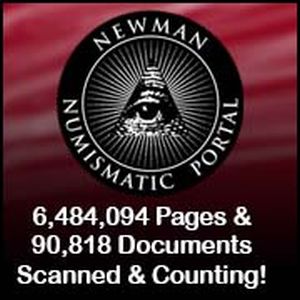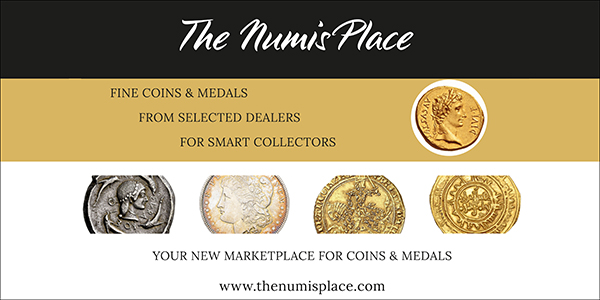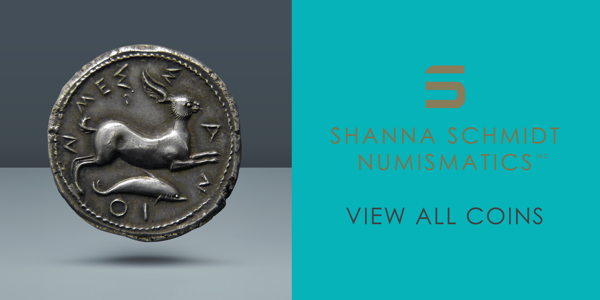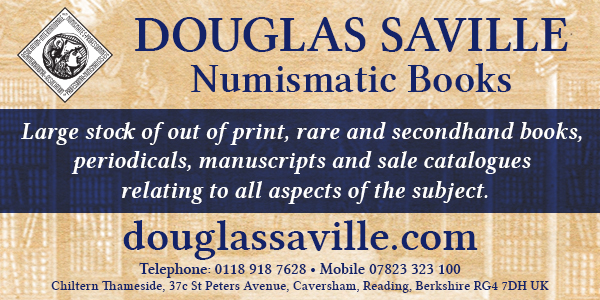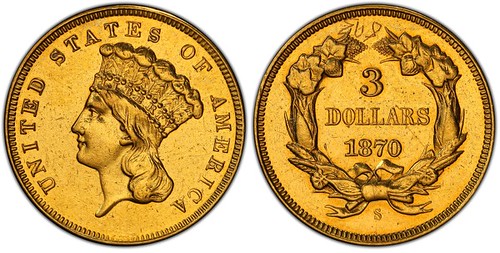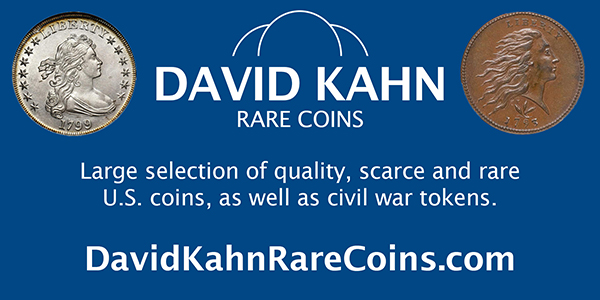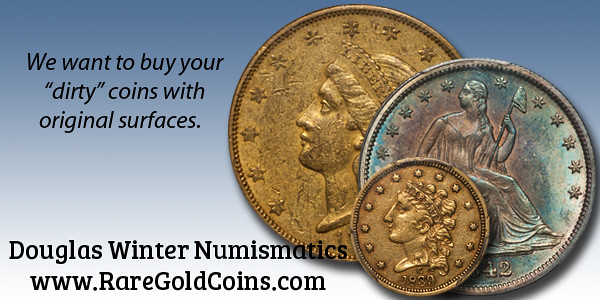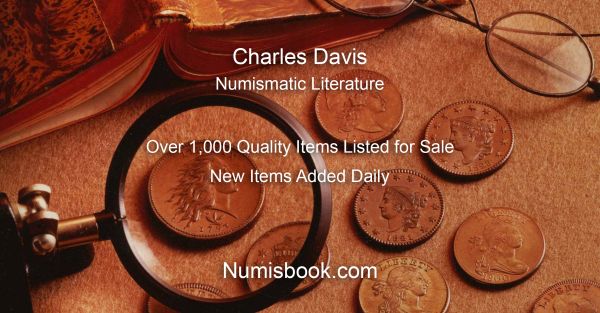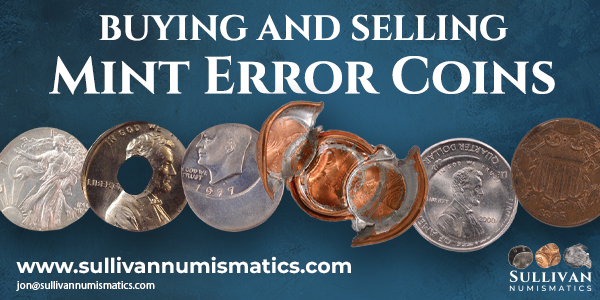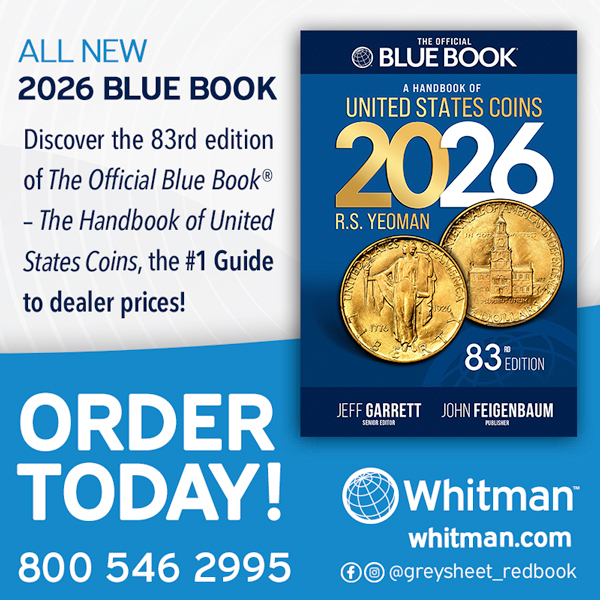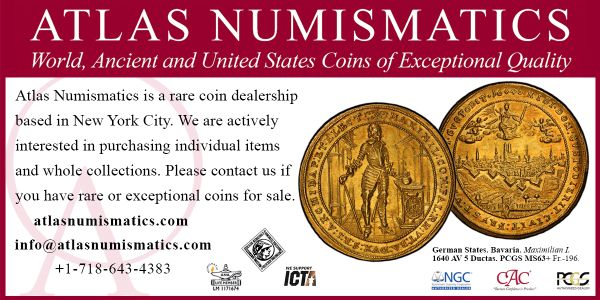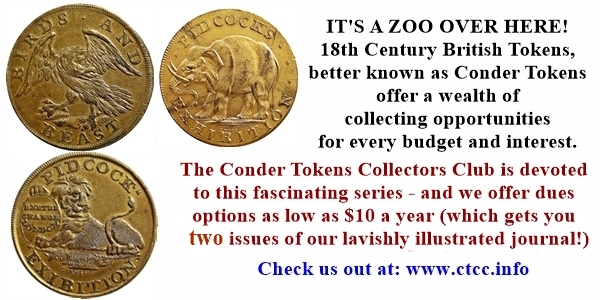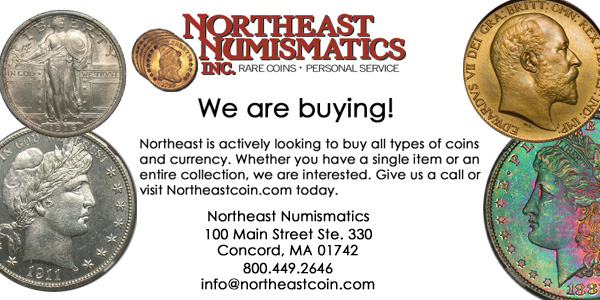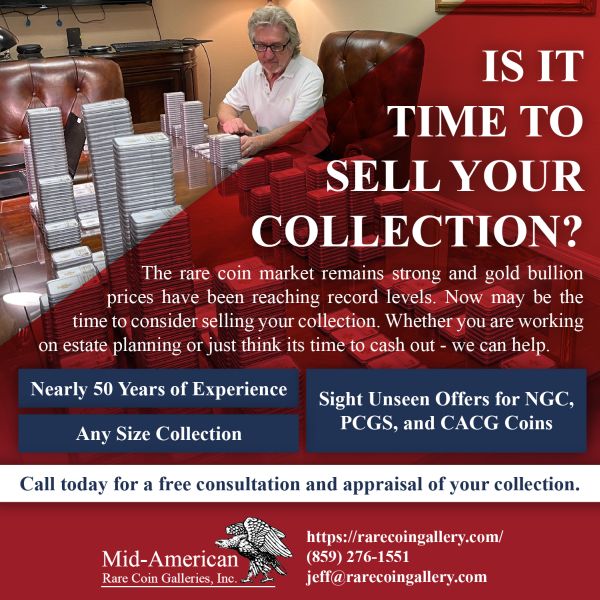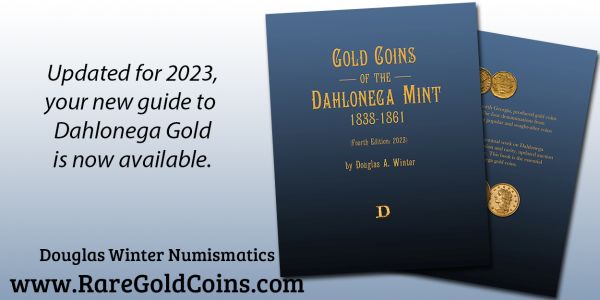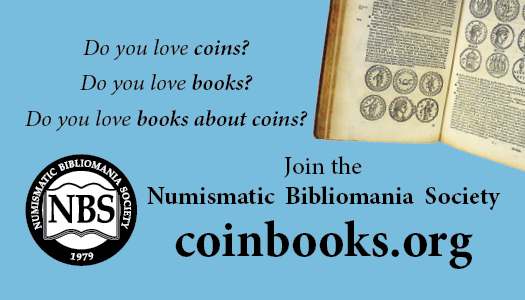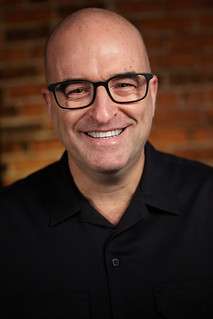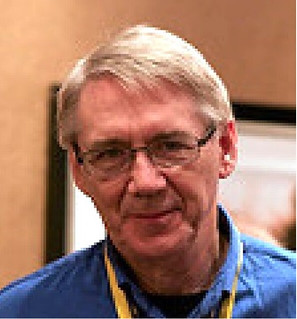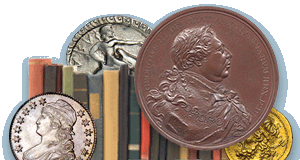
Visit our NBS Sponsors
About UsThe Numismatic Bibliomania Society is a non-profit association devoted to the study and enjoyment of numismatic literature. For more information please see our web site at coinbooks.org SubscriptionsThose wishing to become new E-Sylum subscribers (or wishing to Unsubscribe) can go to the following web page link MembershipThere is a membership application available on the web site Membership Application To join, print the application and return it with your check to the address printed on the application. Print/Digital membership is $40 to addresses in the U.S., and $60 elsewhere. A digital-only membership is available for $25. For those without web access, write to: Jeff Dickerson, Treasurer AsylumFor Asylum mailing address changes and other membership questions, contact Jeff at this email address: treasurer@coinbooks.org SubmissionsTo submit items for publication in The E-Sylum, write to the Editor at this address: whomren@gmail.com BUY THE BOOK BEFORE THE COINSale Calendar
|
- WAYNE'S WORDS: THE E-SYLUM MAY 18, 2025
- KOLBE & FANNING MAY 2025 SALE SELECTIONS
- BOOK REVIEW: THE PUBLICATIONS OF ERIC P. NEWMAN
- NEWMAN PORTAL ADDS HALF CRAZY
- VIDEO: HISTORY BEHIND THE TRADE DOLLAR
- ANA SUMMER SEMINAR 2025, SESSION ONE
- ANA SUMMER SEMINAR 2025, SESSION TWO
- MORE ON SAN FRANCISCO MINT RARITIES
- MORE ON SEDE VACANTE COINS
- NOTES FROM E-SYLUM READERS: MAY 18, 2025
- VOCABULARY TERM: RETROGRADE LETTERING
- JOHN FRANCIS LEBLANC (1887-1964)
- PROFILE: AUTHOR SHANKAR KUMAR BOSE
- DAVISSON'S CUPBOARD SALE ONE
- HERITAGE: OTOH PART IV PHYSICAL CRYPTO SALE
- HERITAGE: NORSE AMERICAN CENTENNIAL MEDALS
- THE COINAGE OF AKRAGAS
- COIN OLDEST KNOWN RECORD OF NAME 'TURK'
- IRON AGE GOLD COIN HOARD TO BE DISPLAYED
- THE 1844-O $5 AND $10 PROOF GOLD COINS
- RECYCLED SILVER PASSES TRIAL OF THE PYX
- SHANGHAI MINT MUSEUM COINECT EXHIBIT
- THE BATTLE AT BREITENFELDT
- COUNTERFEIT NOTES UNDERMINE SYRIA ECONOMY
- SYRIA TO STOP PRINTING BANKNOTES IN RUSSIA
- NEW-DESIGN U.S. BILLS VANISH FROM RUSSIA
- LOOSE CHANGE: MAY 18, 2025
- ABOUT THIS ISSUE: MAY 18, 2025
Content presented in The E-Sylum is not necessarily researched or independently fact-checked, and views expressed do not necessarily represent those of the Numismatic Bibliomania Society.
WAYNE'S WORDS: THE E-SYLUM MAY 18, 2025
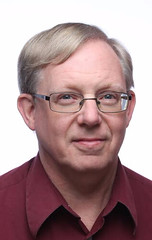 New subscribers this week include:
Angela Carter and Erik Jansen.
Welcome aboard! We now have 7,241 subscribers.
New subscribers this week include:
Angela Carter and Erik Jansen.
Welcome aboard! We now have 7,241 subscribers.
Thank you for reading The E-Sylum. If you enjoy it, please send me the email addresses of friends you think may enjoy it as well and I'll send them a subscription. Contact me at whomren@gmail.com anytime regarding your subscription, or questions, comments or suggestions about our content.
This week we open with a numismatic literature sale, a book review, updates from the Newman Numismatic Portal, the ANA Summer Seminar and more.
Other topics this week include Seated Halves and Trade Dollars, San Francisco Mint rarities, Sede Vacante coins, retrograde lettering, auction previews, an iron age gold coin hoard, the Shanghai Mint Museum, and paper money in Syria and Russia.
To learn more about the New Orleans Mint, the medal in France, Supernotes, Liberian pattern coins, the Money Museum of Boston, numismatic author Shankar Kumar Bose, the Otoh Collection of Physical Cryptocurrency, Norse-American centennial medals, the coinage of Akragas, the 'baseball crack' reverse, and the medals buried with Pope Francis, read on. Have a great week, everyone!
Wayne Homren
Editor, The E-Sylum
KOLBE & FANNING MAY 2025 SALE SELECTIONS
Here's another set of selected lots from the upcoming Kolbe & Fanning numismatic literature sale. -Editor
 Kolbe & Fanning Numismatic Booksellers will be holding our next auction on Saturday, May 31, 2025. Featuring the second half of the L.D. & I.P. Library and additional selections from the library of Barry Tayman, the sale includes rare and out-of-print works on ancient, world and U.S. numismatics. The 500 lots offer something for everybody, with books from the 17th through the 21st century.
Kolbe & Fanning Numismatic Booksellers will be holding our next auction on Saturday, May 31, 2025. Featuring the second half of the L.D. & I.P. Library and additional selections from the library of Barry Tayman, the sale includes rare and out-of-print works on ancient, world and U.S. numismatics. The 500 lots offer something for everybody, with books from the 17th through the 21st century.
Some highlights of this first sale include:
Lot 32: a photographic record of the magnificent collection of Roman gold coins and medallions formed by Leo Biaggi de Blasys
Lot 223: all three folio volumes of Ennio Visconti's incomparable ancient Greek iconography, including a vast array of exquisitely engraved illustrations of ancient coins
Lot 150: Giuseppe Mazzini's Monete imperiali romane, edited by Mario Ratto and published between 1957 and 1958, describing and illustrating over 8000 coins on 531 plates
Lot 177: a complete offering of P. & P. Santamaria's extraordinary 12-volume set of catalogues of the Count Dr. Alessandro Magnaguti collection of ancient and Italian coins and medals
Lot 265: John J. Ford, Jr.'s notes on Canadian tokens and Franco-American coins, including original photographs and other illustrations, manuscript notes, and correspondence
Lot 285: a complete set of the deluxe editions prepared for the first five volumes of Harrington Manville's Encyclopaedia of British Numismatics
Lot 290: José Toribio Medina's 1924 classic Medallas europeas relativas a América, discussing in extensive detail nearly 500 different medals of North, Central and South America
Lot 361: a photographically plated copy of S.H. Chapman's catalogue of the F.G. Simpson collection, one of the rarest of the plated Chapman catalogues, with only five examples traced.
Lot 324: a finely bound set of the American Journal of Numismatics, the cornerstone of American numismatic literature and one of the true landmark publications in the field
Lot 339: Burdette Johnson's archives relating to the Virgil Brand collection and Johnson's role in the disposition of parts of the collection on behalf of the Brand Estate
Review Bidder Information
When registering to bid, please review your contact and payment information, especially shipping address, to ensure that your lots are shipped quickly and correctly.
Register early to bid online
Bids may be placed via post, email, phone, as well as online. Kolbe & Fanning use Auction Mobility as our third-party online bidding platform. Auction Mobility is an app-based platform allowing users the ability to participate in the sale through phones, tablets and computers. To register for the sale, bidders must go to
bid.numislit.com and sign up. Once you have set up an account, you may browse lots, place advance bids, or participate in the live sale online. Those wishing to participate on their devices can download the Kolbe & Fanning app through the Apple or Google Play Store. The sale has been listed on Biddr and NumisBids.
The printed catalogue is being mailed to all active customers on our mailing list. As international mail speeds have been inconsistent, we encourage our foreign clients to consult the electronic catalogue in case their printed catalogue does not arrive promptly. A PDF of the printed catalogue has been posted to our main website at numislit.com for those who prefer that format. Bids placed via post, email, or phone must be received by May 30, the day before the sale, in order for them to be processed. Advance absentee bids may also be placed at any time online at bid.numislit.com. Internet bidding will be available during the sale itself through the same platform.
To read the earlier E-Sylum article, see:
KOLBE & FANNING MAY 2025 SALE ANNOUNCED
(https://www.coinbooks.org/v28/esylum_v28n19a03.html)
BOOK REVIEW: THE PUBLICATIONS OF ERIC P. NEWMAN
Jeff Burke submitted this review of the new book on the publications of Eric P. Newman. Thank you! To order a copy, see the earlier article linked below. -Editor
By Jeff Burke
 From start to finish, The Publications of Eric P. Newman: A Collector's Guide is an enticing
read for bibliophiles and connoisseurs of Eric Newman's numismatic scholarship. I gained a
greater appreciation for his diligence as a researcher and writer, as well as his meticulous
preparation of manuscripts for publication. I was astonished at the sheer number of novel
discoveries that Newman made and followed up on over a period of more than seventy years.
This book is a page-turner, as one anticipates the next numismatic mystery to be investigated by
Newman. It is worth savoring each page!
From start to finish, The Publications of Eric P. Newman: A Collector's Guide is an enticing
read for bibliophiles and connoisseurs of Eric Newman's numismatic scholarship. I gained a
greater appreciation for his diligence as a researcher and writer, as well as his meticulous
preparation of manuscripts for publication. I was astonished at the sheer number of novel
discoveries that Newman made and followed up on over a period of more than seventy years.
This book is a page-turner, as one anticipates the next numismatic mystery to be investigated by
Newman. It is worth savoring each page!
This expertly researched, organized, well-illustrated and edited volume is not a hagiography of Newman or his scholarship. It is a creative presentation of Newman's personal papers and library artifacts intertwined with his published works. The authors provide clarity when Newman's research findings have been updated by more recent numismatic research. They also review Eric's rare failures or limits to his scholarship.
One point that stood out to me was Newman's hardline approach against the merits of numismatic copies, alterations or forgeries. While I understand the hazards of these, in my experience, some coin reproductions may be useful tools for educating numismatists about the diagnostics of authentic versus spurious coins. For example, I benefited from examining and comparing original gold coins of various denominations, early American coppers, Indian Head and Flying Eagle cents to matching counterfeit coins during my classes at several American Numismatic Association Summer Seminars.
Orosz and Augsburger are to be commended for producing this engaging guide to Newman's body of scholarship. I especially recommend this book for learning about Newman's tackling of significant numismatic questions.
To read the earlier E-Sylum articles, see:
NEW BOOK: PUBLICATIONS OF ERIC P. NEWMAN
(https://www.coinbooks.org/v28/esylum_v28n09a03.html)
BOOK REVIEW: THE PUBLICATIONS OF ERIC P. NEWMAN
(https://www.coinbooks.org/v28/esylum_v28n10a07.html)
NEWMAN PORTAL ADDS HALF CRAZY
The latest addition to the Newman Numismatic Portal is the Seated Half Society's Half Crazy. Project Coordinator Len Augsburger provided the following report. -Editor
Newman Portal Adds Half Crazy
 Recently added to Newman Portal is the latest issue of Half Crazy, the electronic publication of the Seated Half Society. The Bill Bugert volumes on the Liberty Seated Half Dollar (1839-1891) die varieties, first appearing in 2010, have spurred interest in this long running 19th century American series. Although the set consists of over a thousand die marriages, these coins were produced in large quantities, and many varieties are available at accessible prices.
Recently added to Newman Portal is the latest issue of Half Crazy, the electronic publication of the Seated Half Society. The Bill Bugert volumes on the Liberty Seated Half Dollar (1839-1891) die varieties, first appearing in 2010, have spurred interest in this long running 19th century American series. Although the set consists of over a thousand die marriages, these coins were produced in large quantities, and many varieties are available at accessible prices.
The current issue of Half Crazy includes an interview with John Dannreuther on proof coinage, a call for census information on the 1849 Doubled Date and 1873 No Arrows Open 3 varieties, and an overview of the 1841-O "baseball crack" reverse. Half Crazy is edited by Dennis Fortier and is issued quarterly. To subscribe, contact Dennis at ricajun@msn.com.
Image: 1841-O 50c w/"baseball crack" reverse, PCGS EF45, Heritage Auctions 2017 Winter FUN, lot 4345, realized $2,820. Image courtesy of Heritage Auctions. The arcing die cracks emulate the seams of a baseball.
Link to Half Crazy on Newman Portal:
https://nnp.wustl.edu/library/publisherdetail/548913
Link to Bill Bugert publications on Newman Portal:
https://nnp.wustl.edu/library/booksbyauthor/361
THE BOOK BAZARRE
VIDEO: HISTORY BEHIND THE TRADE DOLLAR
The David Lisot Video Library on the Newman Numismatic Portal can be found at:
https://nnp.wustl.edu/library/multimediadetail/522852
We highlight one of his videos each week in The E-Sylum. Here's one from 2009 with Andrew Caletti speaking about the U.S. Trade Dollar. -Editor
By the mid-19th century, international trade in the Orient was booming. America needed an export outlet in its silver and a coin to aid its traders in the Orient. Find out why the U.S. Trade dollar was created and why its lifespan was so short. Andrew Caletti is the ANA's 2009 Harry W. Bass Numismatic Intern.
Speaker(s): Andrew Caletti, ANA Bass Intern.
To watch the complete video, see:
History Behind the Trade Dollar: The Harry Bass Collection
(https://youtu.be/AdjFrK5Y2Es)
History Behind the Trade Dollar: The Harry Bass Collection
(https://nnp.wustl.edu/library/book/557330)
ANA SUMMER SEMINAR 2025, SESSION ONE
A few classes for ANA's Summer Seminar 2025 are still open, so register now while you still can! Summer Seminar is one of the premier educational experiences in numismatics. -Garrett
 Summer Seminar is a once-a-year opportunity for numismatic learning and camaraderie that offers students a varied selection of weeklong courses designed for discovery or continued study.
Summer Seminar is a once-a-year opportunity for numismatic learning and camaraderie that offers students a varied selection of weeklong courses designed for discovery or continued study.
For many students, Summer Seminar is a life-changing event; it has catapulted the careers of several of the nation's most respected collectors, authors and dealers. Classes are designed to suit every collector's interests and include courses such as: Grading U.S. Coins, Detecting Counterfeit and Altered Coins, ancient Greek and Roman coinage, Early American Copper Coinage, Colonial Americana, Morgan Dollars, World Numismatics, and much more.
Students gather in small groups, allowing everyone to be an active participant. You'll learn from instructors who are recognized leaders in their fields, and from the collective experiences of fellow students, who range in age from teenagers to seniors. Students may select from a variety of tuition and lodging options to meet their needs, preferences and budget. Activities include seminars and lectures, special events, great food, receptions and banquets, and optional tours.
Here are the remaining session one classes for Summer Seminar 2025:
Session 1
World Coin Grading
This course focuses on learning grading standards for world coins from the perspective of American grading services. The course includes instruction on grading vintage and modern world coins, including normal or special strikes, as well as milled and non-milled coinage. Segments of the course are dedicated to detecting and identifying no-grade and problem coins, as well as counterfeit-coin detection.
Instructors: Jay Turner, senior world coin grader, PCGS; and Dylan Dominguez, junior world coin grader, PCGS.
Introduction to Counterfeit & Alteration
Learn how counterfeits are made from ancient times to today. Chinese counterfeits that have entered the coin market over the last 30 years are emphasized. This plague is not because of the sophistication of counterfeits but because of the sheer number in the market. Examine Chinese counterfeits and see how easily you can spot them. If you work in law enforcement, you'll gain the confidence to go to court and prove your case. If you're buying coins online or through the mail, or work at a coin shop, pawn shop, or as a vest pocket dealer, you will benefit from this class.
Instructors: Brian Silliman, professional numismatist, Brian Silliman Rare Coins, and former NGC grader/conserver and ANA authenticator/conserver; and Jim Robinson, professional numismatist, APMEX
The Wonderful World of Paper Money
Paper money has been used for centuries, primarily for economic purposes but also for many others. Just as the Romans used their coinage to advertise Imperial accomplishments, so paper in later centuries has been used to celebrate a nation's history, peoples, and conquests. During hard times, the paper usually reflects those issues. Take a tour covering more than 600 years of paper money, including how it is made, what it represents, its artistry, and where it is going from here. (Soon it may not be "paper" money any longer.) Classroom time includes many hours of handling notes, not simply reviewing slideshows. Pick the countries or periods you are interested in and enjoy.
Instructor: Joseph E. Boling, ANA chief exhibit judge, coauthor of World War II Remembered: History in Your Hands, A Numismatic Study
The Modern Minting Process: Errors & Varieties
Explore the minting process and learn how each step can lead to a collectable coin. Topics include how coins are produced, the identification and description of errors, and the art of cherrypicking varieties. Included is hands-on examination of some amazing error and variety coins. Students are encouraged to also bring their own errors or varieties to discuss. A visit to the Moonlight Mint is included, where students watch the production process, from the design phase to the striking of coins. Students also get to press the button on a Grabener coin press to strike their own medallions to take home. This class fulfills the "Modern Minting Process/U.S. Minting Errors and Varieties" course requirement for the ANA Numismatic Diploma Program.
Instructors: John H. Miller Jr., ANA district representative and CONECA variety attributor; and Greg Bennick, error specialist, CONECA and TAMS board member
Numismatic Digital Photography & Image Editing
This course is designed for beginners through advanced photographers who want to learn basic and advanced techniques to take photographs of numismatic items and manage their digital coin collection, using photographs to sell coins online, conduct research using numismatic photographs, perform diagnostic inspection of numismatic items, or submit images for publication. Learn how to use multiple lighting configurations and get the most out of your equipment. Discover proper image capture and file handling methods for efficiency. Learn basic numismatic editing techniques using Adobe Photoshop/Elements to produce proper image results and management. Students are encouraged (but not required) to bring a DSLR camera with a macro lens, a laptop with Photoshop or Photoshop Elements, and several personal numismatic items to photograph.
Instructors: Clark Fogg, CSI forensic consultant and numismatic photographer, historian, and author; and David Heinrich, numismatic editor and photographer, ANA governor
Collecting and Investing in Morgan Silver Dollars
This course provides a comprehensive and professional overview of collecting and investing in Morgan silver dollars. Discover the subtle nuances of the dates and mintmarks, and learn about varieties, die states, prooflike (PL), and deep mirror prooflike (DMPL) coins, planchet variations, strike, toning, and eye appeal. Students study extant populations, grading and grading services, wholesale and retail pricing, supply and demand, and critical resources of information. Using actual examples, learn how to grade, as well as determine, rare die varieties and errors, and learn how best to buy, sell, or trade Morgan dollars.
Whether you are a beginning collector, dealer, or seasoned Morgan collector, you will learn about collecting and investing in Morgan dollars from two of the most knowledgeable and well-respected experts on the subject. The knowledge gained from this class will serve you well throughout the course of your collecting and investing in one of the most popular series in numismatics.
Instructors: John Baumgart, owner, Variety Slabbing Service; Chris Simpson, founding member, grader, and main variety attributor with CAC Grading
Collecting and Attributing Capped Bust Half Dollars
This course provides students with a brief history of U.S. coins from 1792 to 1832, focusing on the Capped Bust half dollar. This course covers the minting process and variety attribution. Students receive hands-on experience in determining Overton varieties on many Capped Bust half dollars. This seminar also discusses grading Capped Bust half dollars, as well as counterfeit detection.
Instructors: Bruce Breedlove, coin dealer and collector, cofounder of Classic City Coin Club (Athens, Georgia); Eric Kibbey, owner of Camelot Coins, LLC, secretary of Richmond Coin and Currency Club (Richmond, Indiana); Steven Roach, ANA numismatic educator
Coins of the Roman Republic
Coins uniquely illustrate ancient Roman culture. Using resources from the Edward C. Rochette Money Museum and Dwight N. Manley Numismatic Library collections, students follow the development of Roman Republican coinage – from its Greek roots to its eventual dominance of the Mediterranean economy under the Roman Empire. This fascinating journey brings to life the intriguing political figures, mysterious gods and goddesses, and exciting historical events of this volatile time.
Instructors: Douglas Mudd, ANA Money Museum curator and director, and instructor at the ANA Summer Seminar since 2002; and Kerry K. Wetterstrom, past president of the Ancient Coin Collectors Guild, former auction director and senior numismatist at Classical Numismatic Group, former editor and publisher of The Celator magazine, and an instructor at the ANA Summer Seminar since 1990
Greek Coins from the Origin of Money to the Rise of Alexander the Great
This seminar examines the origins of coinage in 7th century B.C., Asia Minor and the adoption of coins throughout the Greek world through the rise of Alexander the Great of Macedon in 336 B.C.
Instructors: Mike Gasvoda, managing director of Classical Numismatic Group; and Dave Michaels, director of shows and assignments at Classical Numismatic Group (Lancaster, Pennsylvania, and London, England)
Early American Copper Coinage (Copper 1)
This course provides an introduction to early American coppers. Students gain a basic understanding of early American coppers, including how they were distributed by the mint, where and how they circulated, how to determine if a copper has been cleaned or altered, and how restrikes were made. Learn how to grade and attribute higher-graded coins. Topics are student-driven—if you want to know something, just ask! Bring your loupe and any coppers you would like to share.
Instructors: Jim Carr, Early American Coppers (EAC) member, professional numismatist, Carr's Coins; and Kevin Vinton
The New Orleans Mint Coinage and its History
This course covers the coins and the history of the New Orleans Mint from its origin in 1835 to its final closure in 1909. The silver and gold coins produced at the New Orleans Mint are comparable to the Philadelphia Mint both in type and quantity. From arduous early days marked by epidemics and deaths, a struggle to mint coins with limited dies being stored in tropical conditions, to changing hands three times during the Civil War, its complicated history is written in its coins. The course includes discussions of the 40 (or so) types of New Orleans coins, individual dates, major varieties, grading, and hands-on attribution exercises.
Instructors: Craig Eberhart, secretary, Liberty Seated Collectors Club; Len Augsburger, project coordinator of Newman Numismatic Portal, president of the Liberty Seated Collectors Club, president of Numismatic Bibliomania Society; and John Frost, director of education of the Liberty Seated Collectors Club and president of the Barber Coin Collectors Society
A Survey of 20th- & 21st-Century World Coins
Participants in this class have the opportunity to appreciate the artistry, history, geography, people, and stories of the modern world through the study of modern world coinage. Participants explore common, scarce, artistic, ugly coins. Knowledge will range from general to specifics in areas of general issues, commemoratives, metals, designers, mintages, patterns, errors, and topicals. Grading and the preparation of balanced talks, articles, and exhibits of modern issues are discussed.
Instructor: Benjamin Swagerty, media specialist for OKCPS, master referee for Numista, international numismatic researcher
To read the full course catalog and register, see:
2025 Summer Seminar
(https://www.money.org/summer-seminar/)
ANA SUMMER SEMINAR 2025, SESSION TWO
A few classes for ANA's Summer Seminar 2025 are still open, so register now while you still can! Summer Seminar is one of the premier educational experiences in numismatics. Here are the remaining session two offerings. -Garrett
Session 2
 Advanced United States Coin Grading & Problem Coins
Advanced United States Coin Grading & Problem Coins
Discover the nuances of high-grade, mint-state, and proof coins. Learn how to distinguish original surfaces from mint-state and circulated coins that have been cleaned or altered, and how to identify minute imperfections and color variances that can affect a coin's grade. Find out the methods experts use, as well as their own strengths and weaknesses. Enrollment is limited to 24 students.
Prerequisite: Successful completion of "Grading United States Coins, Parts 1 and 2" or instructor permission.
Instructors: Don Ketterling, professional numismatist, D.H. Ketterling Consulting; and Jeff Garrett, Mid-American Rare Coin Galleries, senior editor; and Ken Park
Counterfeits, Alteration Detection & Problem Coins
Learn the often-subtle differences between genuine, counterfeit, and altered coins while applying your skills using the ANA's counterfeit detection set of more than 400 coins, including U.S., world, ancient, and colonial specimens. Students handle "raw" genuine and spurious coins under instructor supervision. Topics include counterfeit-coin production, types of counterfeit dies and castings, date and mintmark alterations, specific gravity testing, and the use of microscopes.
Instructors: Brian Silliman, owner, Brian Silliman Rare Coins, former NGC grader/conserver and ANA authenticator/ conserver; H. Robert Campbell, ANA past president, owner of All About Coins, and recognized expert on toning; and Keith Moon, owner of Gem Mint Coin, LLC and former grader/finalizer for ANACS, NGC, and PCGS
Advanced Coin Dealing
Get into the coin business, open your own coin shop, and learn different ways to increase profit potential through business development. Topics covered include basic business accounting, economics, finance, marketing, management concepts, methods, and tools. Also learn inventory control, security, and ethical management. The class emphasizes practical examples to help you employ techniques learned immediately in your business. This class is designed for both new and experienced business owners and coin collectors. Whether you want to improve an existing business or start a new one, this course provides you with the tools and insights to succeed. The class is taught by an experienced coin shop owner. Class size is limited, so early registration is suggested.
Instructors: Robert Oberth, owner of Gold & Coin Exchange, GHA certified diamond graduate and lifetime member of American Numismatic Association, Roundtable authorized dealer, Professional Numismatists Guild; Kenny Duncan, Jr., U.S. Coins and Jewelry; and Seth Chandler, Witter Coin
World Bank Notes, 1950 to Date
Participants in this class have the opportunity to appreciate the artistry, history, geography, people, culture, and stories of the modern world through modern world bank notes. Explore common, scarce, artistic, and ugly (but always interesting) world bank notes. Knowledge starts from generalities to specifics in areas of general issues, commemorative, polymers, other substrates, designers, imprints, and topical themes. Grading and the preparation of talks, articles, exhibits, and presentations of bank notes will be discussed.
Instructor: Benjamin Swagerty, media specialist for OKCPS, master referee for Numista, international numismatic researcher
Advanced Topics in Early American Copper (Copper 2)
This course is an extension of the "Early American Copper Coinage (Copper 1)." It deals with advanced identification and basic understanding of early American coppers. Topics are student-driven—if you want to know something, just ask! Bring your loupe and any coppers you would like to share.
Prerequisite: Successful completion of "Early American Copper Coinage (Copper 1)"
Instructor: Jim Carr, EAC member, professional numismatist, Carr's Coins
Classic Commemorative Coins
This course is a review of all early commemorative silver and gold coins (1892- 1954). Students also review some associated coins and medals. Grading characteristics and varieties are reviewed and discussed. Many coins of various grades will be inspected throughout the course.
Instructor: Carl Stang, contributor to The Numismatist and expert on commemorative coins
Evolution of Western Coinage through Economics & Iconography
This interdisciplinary course traces the evolution of coinage throughout history from both an economic and iconographic perspective. The two instructors complement each other by illustrating the same period of time each day from these two disciplines' viewpoints. Greg Thompson follows the course of human economic development from barter through the modern credit economy. Allen Berman traces coinage as a means of communication through the trends of art over the centuries.
Instructors: Allen G. Berman, professional numismatist; and Greg Thompson, owner, Money-Changers
The Glorious History of the Medal in France
While the modern portrait medal originated in Italy, by the 17th century, the most artistically innovative and technically advanced medals were being produced at the Paris Mint. The French would continue to set the standards for the finest medals into the 20th century. This course looks at the history of medal production in France from the early days of the Renaissance through the medals of Henry IV, Louis XIII and Louis XIV, Napoleon, and later medals of the Republic. Study the work of engravers including Warin, Dupré, Duvivier, and others. Explore the change in style from the Baroque and Classical periods to the Art Nouveau, Art Deco and contemporary styles, looking at the medals of Roti, Chaplain, Turin, and many more.
Instructor: David Menchell, ANA district representative, exhibit judge and award-winning exhibitor
Art of Engraving
This class is intended to perpetuate the skill set of medallic engraving, bridge the gap between artists and numismatics, and foster knowledge in both the art form and the mechanics of historic and current coin and medal production. Die engraving is an ancient art form; this course is built on a two-year timeline to teach artists how coins and medals were traditionally created. The first year's focus is bas relief and exposure to working sculpturally in the negative, in plaster. The second year builds on this knowledge and skill set, but focuses further on hand cutting steel dies for striking small medals, to include creating their own engraving tools. During the second year, all work is done in the negative, in steel. The class is time intensive and requires long periods of focus and concentration. Applicants are selected based on portfolio review.
Note: This class is only offered by scholarship. You will not be able to register until you complete the scholarship form, found at money.org/ana-summer-seminar-scholarships.
Instructor: Laura Stocklin
To read the full course catalog and register, see:
2025 Summer Seminar
(https://www.money.org/summer-seminar/)
MORE ON SAN FRANCISCO MINT RARITIES
Nancy Oliver and Richard Kelly submitted these notes on some of the coins discussed in the 100 Greatest U.S. Coins book. Thanks! -Editor
First the 1894 S dime.
The story of SF Mint Superintendent John Daggett giving any of the 1894 S's to his daughter Hallie is a complete falsehood. We made three separate trips to Siskiyou County, California to investigate, and found that Hallie had absolutely no knowledge of this issue. Further inquiries, in various national newspapers, found that SF mint officials confirmed that in June of 1894, the mint had melted several thousands of dollars of uncurrent silver coin to make into new denominations, and at the end of the melt they had but enough left over to strike just the 24 pieces – thinking at the same time that they would strike more later in the year. The 21 pieces (3 total were sent for assay – one for the Assay Commission's yearly test, and two for a special assay) were then placed in a mint coin bag, and sent on their way – and yes, that bag may have made it to a bank in Ukiah, California. There was never any special striking ceremony for their production.
Now the 1870 S Silver Dollar.
SF Mint Coiner, Joseph Breck Harmstead, sent back to Philadelphia two reverse dies, for the 3 dollar gold – neither of which were sent from Philadelphia with the required mintmark S. He did not send back any silver dollar dies since they had several reverse dies (with mintmarks) available for use from previous years. Two well known silver dollar experts from the Liberty Seated Collectors Club have determined that the obverse die for this issue was actually a Carson City obverse die sent to SF – because SF never had one sent to them from Philadelphia. Thus, a SF request for one from Carson, that mint complied.
Lastly, the 1870 S three dollar gold.
We have researched this coin extensively as well, starting with our book on Joseph Harmstead himself, that we wrote in 2005. He, unfortunately, never notes in his records the reason for his striking of the second coin, except for the reported accompanying note with the coin (that note is missing). And yes, he did strike two pieces. In 2006 or so, we discovered a government warrant expressing exactly what coins were placed into that SF Mint cornerstone in May of 1870, and it includes a second piece. (That cornerstone's location is known to us, but we are not at liberty to divulge).
In addition, we have recently theorized that Harmstead struck one of those pieces for his wife, Frances. After her death in 1886, Harmstead gave it to his stepdaughter. Harmstead died in 1889, and his stepdaughter died in 1901. The husband of his stepdaughter then took possession of the coin, with the accompanying note, and gave it eventually to his son (his only child) who was a teacher in New York City. This son sold it to Henry VanCamp, and well you know the rest."
Thank you! See also an article elsewhere in this issue about the 1844-O $5 and $10 Proof Gold Coins. -Editor
To read the earlier E-Sylum article, see:
A 100 GREATEST U.S. COINS COLLECTION
(https://www.coinbooks.org/v28/esylum_v28n19a17.html)
MORE ON SEDE VACANTE COINS
Martin Purdy of New Zealand writes:
"I enjoyed the item on Sede Vacante coins in the latest E-Sylum. I put together a small piece on the same subject for a local online group a few days ago and photographed the small number of "S.V." coins I have to go with it. It was the first time I'd put the 1958 and 1963 coins side by side and noticed that they were pretty much identical, except for the change of one letter in the date as spelled out in Roman numerals on each - MCMLVIII and MCMLXIII respectively. I suspect the same dies were used but just with a switch-out of that V for an X for the later issue. Folks with better eyes or technical equipment than I have may be able to detect more differences but that was as far as I got.
"I was therefore amused to see that the "1958" coin accompanying the E-Sylum is actually a 1963 piece - a very easy mistake to make in the light of the above."
Martin provided the text and images from his Facebook posts. Thank you! -Editor
 Here's a page from a catalogue I used to read over and over as a kid. I used to wonder,
looking at the Papal States and Vatican sections, what this regular "Sede Vacante" thing was,
and it was a while before I realised it meant, literally, that the Holy See was vacant, i.e. a time
between popes with no-one in office. I've no idea how far back the practice of striking coins
for these occasions goes but clearly it has been done for centuries.
Here's a page from a catalogue I used to read over and over as a kid. I used to wonder,
looking at the Papal States and Vatican sections, what this regular "Sede Vacante" thing was,
and it was a while before I realised it meant, literally, that the Holy See was vacant, i.e. a time
between popes with no-one in office. I've no idea how far back the practice of striking coins
for these occasions goes but clearly it has been done for centuries.
During the later 20th century there were some nice silver commemorative pieces that aren't all that expensive to obtain - and two of them in 1978, since there were two gaps that year, before and after John Paul I, who lasted only slightly over a month in office.
I see online that they still made 2-euro Sede Vacante commemoratives in 2005 and 2013, but probably due to the proportional mintage rules for Euro coinage there aren't enough Vatican euro commemoratives to meet demand and that's reflected in the prices. I guess there'll be another this year to continue the series.
Vatican City, Sede Vacante (Interregnum between Popes), 500 Lire 1963 (in card) and 1958 (in red presentation case). At a quick glance it looks like they may have dug out the dies for the 1958 coin and swapped the Roman numeral V in the date for an X to reuse it five years later Apologies for the quality of the 1958 pics - I wasn't going to risk damaging an old polythene sleeve to get the photos.
1978 Sede Vacante coin (first issue): This one has a similar design to the 1958 and 1963 ones, but has a slightly more "arty" treatment to the design elements and lettering.
To read the complete article, see:
SEDE VACANTE COINS
(https://www.coinbooks.org/v28/esylum_v28n19a25.html)
NOTES FROM E-SYLUM READERS: MAY 18, 2025
Papal States Paper
With the Pope so much in the news these days,
#1 Money Man writes:
"Here's a paper relic of the (short-lived) Napoleonic conquest of the Repubblica Romana-Papal States (where Napoleon himself was not head of his troops, but conquered by Berthier)."
Thanks. I wasn't familiar with these. -Editor
On the Oxford English Dictionary
Mike Hodder writes:
 "Thanks for the piece on English dictionaries. These tend to be appreciated by a small number of bibliophiles. My most prized personal possession (to paraphrase Ren & Stimpy) is my 20 vol. folio Oxford English Dictionary. If I were to be marooned on a desert island and could take only one thing with me from my library it would be my complete OED. The etymologies, chronological examples of usage and editorial comments are précis of the history of the language and the nation in which it grew up and are always both informative and highly rewarding."
"Thanks for the piece on English dictionaries. These tend to be appreciated by a small number of bibliophiles. My most prized personal possession (to paraphrase Ren & Stimpy) is my 20 vol. folio Oxford English Dictionary. If I were to be marooned on a desert island and could take only one thing with me from my library it would be my complete OED. The etymologies, chronological examples of usage and editorial comments are précis of the history of the language and the nation in which it grew up and are always both informative and highly rewarding."
Indeed! In a past life I'm certain many numismatists were lexicographers or librarians; I have an innate urge to make order of the chaos around me. -Editor
To read the earlier E-Sylum article, see:
HISTORY OF THE ENGLISH DICTIONARY
(https://www.coinbooks.org/v27/esylum_v27n19a24.html)
On Grading Damaged Coins
John Regitko of Toronto, Canada. writes:
 "As for the condition of the U.S. gold coin, the best grade I can come up with is BUBAR, an acronym for "Buggered up Beyond All Recognition".
The movie Saving Private Ryan used a similar phrase, FUBAR, with a similar meaning."
"As for the condition of the U.S. gold coin, the best grade I can come up with is BUBAR, an acronym for "Buggered up Beyond All Recognition".
The movie Saving Private Ryan used a similar phrase, FUBAR, with a similar meaning."
I guess I'd push back against the "Beyond All Recognition" part. It's clearly a U.S. gold coin and while the date is unreadable the unobscured part of the design narrows the possibilities, and the size and weight indicate the denomination. I wonder if conservation was able to rescue this one. -Editor
To read the earlier E-Sylum article, see:
TREASURE TALK WITH BOB EVANS, EPISODE 4.2
(https://www.coinbooks.org/v28/esylum_v28n19a20.html)
BEP Director Reviews 'Supernote'
Former Bureau of Engraving and Printing Director
(and ANA Executive Director) Bob Leuver writes:
 "I just finished reading the book Supernote, the intriguing story of searching for the printer of 'supernotes' by SA Ross Garret, US Secret Service, was easy to follow. The book highlighted the work of the Secret Service Counterfeit Division, or, at least, how the SS goes after counterfeiters.
"I just finished reading the book Supernote, the intriguing story of searching for the printer of 'supernotes' by SA Ross Garret, US Secret Service, was easy to follow. The book highlighted the work of the Secret Service Counterfeit Division, or, at least, how the SS goes after counterfeiters.
"However, the book wasn't James Patterson's or David Balducci's style. Attempts were made to make it so. There was a romantic angle that was left hanging about 80% through the book.
"Thank you for bringing the book to our (my) attention."
Glad to help. I'd like to read this one myself someday. -Editor
To read the earlier E-Sylum article, see:
NEW BOOK: SUPERNOTE
(https://www.coinbooks.org/v28/esylum_v28n17a05.html)
On Restrike Terminology
Jerry Nashorn writes:
"The definition of restrikes and the related terms novodel and reissue don't seem to mesh with how these terms are used by grading services, catalogers, numismatic authors and dealers when describing medals. To my knowledge the term restrike is used when the issuer, usually an official mint, produces an example of a medal at some point after the medal was originally issued. The term can describe a medal produced with the original dies or with dies produced at a later date. And the later examples are made as part of an authorized program. For example, the bronze examples of Indian Peace medals are termed restrikes whether produced in the 19th century with the original dies or produced in the 20th century with new ones. This is true of later examples of historical medals struck by the Paris Mint.
"The only time I've seen the term novodel used is in describing Russian coins originally struck in the 18th century or the first years of the 19th century that were produced for sale to collectors using new dies. Until the 1880s the Russian imperial mint issued copies of earlier medals but they generally are termed restrikes.
"I have rarely if ever encountered the term reissue in connection with historical medals."
To read the earlier E-Sylum article, see:
VOCABULARY TERM: RESTRIKE
(https://www.coinbooks.org/v28/esylum_v28n19a18.html)
The Rorschach Fisherperson
Regarding John Linhoss' contention that the 1860 Miller 1008 token represents an African American fishing,
Pete Smith writes:
 "I disagree with the suggestion that the fisherperson on the M. L. Marshall store card was African-American.
An excellent article on Marshall was published in the September 2002 issue of The Numismatist.
This article included a reprint of a letter from Dwight D. Stone in the September 1948 issue of
The Numismatist.
"I disagree with the suggestion that the fisherperson on the M. L. Marshall store card was African-American.
An excellent article on Marshall was published in the September 2002 issue of The Numismatist.
This article included a reprint of a letter from Dwight D. Stone in the September 1948 issue of
The Numismatist.
"On the Marshall card, the face is concealed under a hat, scarf and earmuffs. The small part of the exposed face shows just the profile of an eye and nose. On the medal, this is less than a millimeter in size. This is much too small to represent ethnicity."
I didn't spend much time on this one last week, but I looked at the photo quickly and saw facial features I thought were plausibly African-American and agreed with John. New York being on the Union side in the Civil War made me think that at least we couldn't rule that out.
Pete sent me two enlargements of the piece this week and asked, "What do they look like now?" I responded, "Like a Rorschach test." I have to agree with Pete that there's too little here to determine ethnicity. -Editor
To read the earlier E-Sylum article, see:
NOTES FROM E-SYLUM READERS: MAY 11, 2025 : 1860 Token Pictures African-American Fishing
(https://www.coinbooks.org/v28/esylum_v28n19a15.html)
More on the Wu Zhu Coins of China
Ted Puls writes:
"I thought to add to the article about Wu Zhu coins of China. First the writer may enjoy a great book by A.M Fishman, One Thousand Years of Wu Zhu that he is still selling. It tries to explain the varieties of wu zhu and give a closer date range. But to add to the complexity, I have been developing a spreadsheet of varieties of Wu Zhu. The Fishman book shows the differences in each emperor of the Western Han by calligraphic differences. From this idea, I have so far, 15 columns of wu calligraphy types- just the size of the wu character. This spreadsheet has 1200 lines of varieties in addition to just the wu calligraphy. The coinage often has surface marks some engraved into the surface and some cast. They were also filed, chiseled, and cut to form additional types. I believe the cutting and filing as well as calligraphy date the coins. The surface marks are mint marks of some sort to communicate some unknown information. Some day I hope to break the secret code in this area.
"I hope someone is having as much fun as me."
That's intense! -Editor
Query: Liberian Pattern Coins
Bill Dalzell writes:
"I have a paper coming out soon on some Liberian pattern coins, including three examples plated in the Standard Catalog of World Coins that I have been surprisingly unable to trace. Apparently the image library for those volumes no longer exists. Does anyone recognize the photography style?"
Bill adds:
"These are actually some of the BEST images I've found, believe it or not. A number of the illustrations are from a 1941 Numismatic Scrapbook article. They're (hopefully) the worst images I'll ever have to use!"
Can anyone help? -Editor
To read the earlier E-Sylum article, see:
NOTES FROM E-SYLUM READERS: MAY 11, 2025 : Coin Analysis
(https://www.coinbooks.org/v28/esylum_v28n19a15.html)
Sandrock's Ancient Chinese Cash Notes Sought
Edward E. Cohen writes:
"Perhaps a reader can provide me with a safe website to download a PDF. The sites I've tried all display security warnings. I'm seeking: "Ancient Chinese Cash Notes – The Worlds First Paper Money - Part_II", by John Sandrock."
Can anyone help? I did find a hardcopy of a reprint on eBay from Brooklyn Gallery. -Editor
To read the complete lot description, see:
Ancient Chinese Cash Notes The World's First Paper Money by John E. Sandrock
(https://www.ebay.com/itm/364188981728)
VOCABULARY TERM: RETROGRADE LETTERING
Here's another entry from Dick Johnson's Encyclopedia of Coin and Medal Terminology. -Editor
Retrograde Lettering. Lettering which reads backwards; legend or inscription in mirror image. Lettering – as well as all images – are retrograde in the negative (as in a die); however the term is specifically used when the lettering only is backwards in the positive. This is not always obvious for a given piece if it bears a portrait, for example, since portraits look correct in either positive or negative.
An early example of a retrograde legend is on a Marie de Medicis Queen of France Medallion, 1624, in the Kress collection of the United States National Collection (A1307.56S). See illustration. A later example is in the author's collection: a Tiffany medal has all positive elements except for the name of the maker, it is retrograde. What happened here was a punch with "wrong reading" lettering – intended to be punched into a die – was punched into a medal.
An interesting aspect of retrograde lettering exists with the modern pantograph machine: a die can be cut in contraposition to its model. This change of polarity is accomplished by adjusting the gears (see pantograph). All detail, device and lettering, would be retrograde, but the lettering is the most obvious, as the portrait in a die cut in contrapostion may look acceptable facing either direction.
To read the complete entry on the Newman Numismatic Portal, see:
Retrograde Lettering
(https://nnp.wustl.edu/library/dictionarydetail/516643)
JOHN FRANCIS LEBLANC (1887-1964)
E-Sylum Feature Writer and American Numismatic Biographies author Pete Smith submitted this article on J. F. LeBlanc of Boston. Thank you. -Editor
Regular readers of my articles may have noticed that for the past five weeks my topic has been a person mentioned the previous week. This week I look into J. F. LeBlanc, the business successor to William Hesslein.
John Francis LeBlanc was born in Boston on June 13, 1887. He was the son of Louis LeBlanc (1850-1908) and Adelia Adeline Wanders LeBlanc (1859-1932).
On June 4, 1913, he was married to Mary H. Legendre (1892-1927). They had two sons. In 1916 he was employed with the Liberty Trust Company.
He was admitted to the American Numismatic Association on May 1, 1918. His membership number was 1986. At that time, he was living in Dorchester, Massachusetts.
He joined the American Numismatic Society on November 12, 1920. At about that time, he was a clerk in a bank.
He joined the Boston Numismatic Society in 1921 and was later recognized as a life member.
He placed an ad in The Numismatist of June 1929 from 18 Tremont Street, Room 124, in Boston. His ads occasionally mentioned numismatic literature. He used the name John F. LeBlanc through December 1931.
 In 1932 through the May issue, ads appeared under the name of J. F. LeBlanc still from 18 Tremont Street, In June of 1932 he ran a new ad under the name of Associated Coin and Stamp Co. located at 101 Tremont Street in Boston. The ad noted they were "Successors to Wm. Hesslein." The ad closed with the statement, "An auction will be held shortly. If not on our list, please write us." I am not aware of any auction conducted by the firm. That June ad was the last in The Numismatist. In 1933, they had one ad in Hobbies Magazine.
In 1932 through the May issue, ads appeared under the name of J. F. LeBlanc still from 18 Tremont Street, In June of 1932 he ran a new ad under the name of Associated Coin and Stamp Co. located at 101 Tremont Street in Boston. The ad noted they were "Successors to Wm. Hesslein." The ad closed with the statement, "An auction will be held shortly. If not on our list, please write us." I am not aware of any auction conducted by the firm. That June ad was the last in The Numismatist. In 1933, they had one ad in Hobbies Magazine.
In the August 1934 issue he contributed an article on "The 1853 Half Dollar Without Arrows."
William Hesslein claimed to be "the best-known coin dealer in the United States" based on his extensive advertising. He disappeared mysteriously in 1932. J. F. LeBlanc disappeared in a different way later in 1932. He stopped advertising.
It is possible that LeBlanc had enough business from established customers without the need for promotional advertising. John Coffee described him in 1961 as "A prominent Boston coin dealer."
LeBlanc died in Dorchester on May 10, 1964. He is buried with his wife at Blue Hill Cemetery in Braintree, Massachusetts. His obituary mentioned, "Late member of Bank Officers Assn." It did not mention numismatics.
His life is well documented in public records, but infrequently mentioned in newspapers or in numismatic publications.
The building at 101 Tremont Street in Boston is an eleven story office building, also known as the Paddock Building, built about 1901. It has been the location for several coin dealers.
William Hesslein was located in that building from May 1913 until February 1932.
J. F. LeBlanc and Associated Coin & Stamp was there from 1932 until at least 1961.
Colonial Trading Co., Inc. was there in Suite 500/501 in 1993 to 1998. Proprietors were James E. Skalbe and Russell R. Smith. My article on Skalbe was in The E-Sylum on January 26, 2020. There was a Colonial Trading Co. advertising at 102 Tremont Street in 2003.
There has recently been a Colonial Trading Company at 41 Bromfield Street, operated by Lou Chorney. This was below the Money Museum of Boston. The address is a half block from the Paddock Building. This was mentioned in the December 3, 2023, issue of The E-Sylum.
The Colonial Trading Company has moved to 333 Washington Street in Boston, about two blocks from the Paddock Building. Who can report on the current status of the Money Museum of Boston?
There is still a website for the Money Museum of Boston listing the 41 Bromfeld Street address. Have any of our readers visited before? Does anyone know its current status? -Editor
 The Money Museum of Boston is a non-profit organization committed to sharing the interest, purpose, and knowledge of scarce and historical coins and currency. Being just off the freedom trail in Boston, we have a particular focus on the colonial history of The United States. We look to offer our visitors the opportunity to discover the 2,700 year history of precious metal currency. Each of our tour hosts guide and educate their guests with personalized interactions, eager to share their passion with each revered guest.
The Money Museum of Boston is a non-profit organization committed to sharing the interest, purpose, and knowledge of scarce and historical coins and currency. Being just off the freedom trail in Boston, we have a particular focus on the colonial history of The United States. We look to offer our visitors the opportunity to discover the 2,700 year history of precious metal currency. Each of our tour hosts guide and educate their guests with personalized interactions, eager to share their passion with each revered guest.
Our guides all have been involved in the coin industry for most of their lives and consider their passion of coins and paper money a key component of their identity.
From error coins to the oldest of paper notes, The Money Museum of Boston covers every aspect of our money's history, conceived with the intention to pass along the life-long devotion to the world of money!
To visit the Money Museum of Boston website and Facebook page, see:
The Money Museum of Boston
(https://moneymuseumofboston.org/)
https://www.facebook.com/MoneyMuseumBoston/
To read the earlier E-Sylum articles, see:
JAMES EDWARD SKALBE (1955-2017)
(https://www.coinbooks.org/v23/esylum_v23n04a09.html)
MONEY MUSEUMS IN THE U.S., PART ONE
(https://www.coinbooks.org/v26/esylum_v26n49a16.html)
PROFILE: AUTHOR SHANKAR KUMAR BOSE
This article interviews Indian numismatic author Shankar Kumar Bose. -Editor
 From a banker turning into a renowned numismatist, Shankar Kumar Bose's journey is a fascinating one, as Ranjita Biswas finds out
Kolkata-based Shankar Kumar Bose was a banker when coins from ancestry suddenly made a call and he was enticed, and he then started on a whole new path. At the ripe old age of 87, writer of many books on numismatics, he is still at it, researching, writing and is as enthusiastic as ever in new areas of exploration. Currently, he is collecting documents on the ‘token' banks used to give customers while they waited for service, something now forgotten in the digital age, for his book A Historical Journey of Bank Tokens.
From a banker turning into a renowned numismatist, Shankar Kumar Bose's journey is a fascinating one, as Ranjita Biswas finds out
Kolkata-based Shankar Kumar Bose was a banker when coins from ancestry suddenly made a call and he was enticed, and he then started on a whole new path. At the ripe old age of 87, writer of many books on numismatics, he is still at it, researching, writing and is as enthusiastic as ever in new areas of exploration. Currently, he is collecting documents on the ‘token' banks used to give customers while they waited for service, something now forgotten in the digital age, for his book A Historical Journey of Bank Tokens.
It is quite interesting how Bose, who is originally from Assam, has stepped into the world of coins.
Excerpts of an interview:
From an administrative officer in a PSU bank how did you step into the world of coins?
I was an administrative officer with SBI in Shillong when the bank had participated in a programme celebrating the Jubilee Year of Cherrapunji's Ramakrishna Mission's educational institution. The bank decided to put up a stall titled ‘Story of Money in India' along with other institutions, to attract visitors. I was given the responsibility of curating the collection. I went through many volumes in the (then) Central Library in Shillong – and I was hooked. The exhibition was a great success; even the governor commented on it when he visited there. Perhaps I found my vocation.
You have a wide collection of Assam's Ahom age coins. How did you collect them?
The Ahom kings minted coins liberally. The earliest coins issued by an Ahom ruler is dated 1648 A. D. consisting of silver coins and gold mohurs. In many villages in Sivasagar, Jorhat, etc., where the Ahoms had their capital at different times, many households still had them, but they were unaware of their significance. On my tours I explored those areas, visited jails which often hold the booty of thieves and sniffed around when a house was demolished because at many times they throw up coins ensconced underneath. For my collection, some I bought, some the householders gave voluntarily.
In my book The Coinage of Assam(Volume II) Ahom Period , written in collaboration with Nicholas G. Rhodes of Britain, an internationally acclaimed numismatist, I have written about them.
However, you also say that the Ahoms were not the first kings to mint coins in Assam
Yes. Many scholars till recently assumed that metallic coinage was introduced in Assam only from the 17th century by the Ahom kings but through my sustained research since 1994, I have found that since the 9th century metallic copper coins were introduced by the Mlechchha dynasty of Salastambha about which I have written in The Coinage of Assam, Volume I.
You also say that a coin in Agartala led you to discover a royal lineage
Sometimes it happens quite unexpectedly in our field of work.
We were holding an exhibition there at the government's initiative; it was a huge success. I found out about a king in the adjacent Samatata region, now in Bangladesh, almost accidentally. One day a person came to me bringing an old coin to verify. Even through the mud sticking to it, I could make out it was very old and espied a name Balabhatta. There was not much material I could find about a king or minor raja in that area. But research led me to a king called Rajbhatta in the post-Gupta period and there was a copper plate in his name. I am not an expert, but I surmised this coin was from that period and this king belonged to that reign.
There's also an interesting book written in Bengali on the coins used in tea gardens during the British period in Assam
Yes, they were separate from the other coins in use at that time. The tea garden labourers had to be paid in cash daily or at the end of the week and there was lack of small value currency specially as the state's treasury was greatly denuded after the Burmese invasions in waves that ended in 1826 after the British drove them away from Assam. The road system was not good enough to transport coins from Calcutta (Kolkata). So, the tea planters had to take their own measures and created their own tokens.
You also used to collect historical books and journals on the North East. What of them?
Yes, I did, often scouring the second-hand book stalls on College Street and around the Reserve Bank of India in the Dalhousie area.
What's in the pipeline?
I am compiling data on indigenous banks during the British period. Most of them died down later or morphed into PSU banks like the State Bank of India, which is rooted in the Bank of Bengal, changing into the Imperial Bank in colonial times.
In Assam, the individual bank tradition goes back to 1899 when a bank named Assam Bank and Commercial Company was established in Dibrugarh. In Shillong I have found reference to a bank called Banking Corporation of India established in 1901.
To read the complete article, see:
A coin historian
(https://www.dailyexcelsior.com/a-coin-historian/)
To read the earlier E-Sylum articles, see:
NEW BOOK: THE COINAGE OF TRIPURA
(https://www.coinbooks.org/v23/esylum_v23n28a03.html)
TEA TOKENS
(https://www.coinbooks.org/v26/esylum_v26n43a25.html)
DAVISSON'S CUPBOARD SALE ONE
Allan, Marnie, & Lief Davisson have announced their first "Cupboard Sale" of worthwhile items of relatively low value. Not every numismatically or historically significant coin is expensive - have a look through the sale! For bibliophiles, there are some literature lots at the end of the catalog. -Editor
 Welcome to the inaugural "Davissons Ltd. Cupboard Sale" featuring interesting, collectible coins, tokens, medals, and books, all estimated at or below $100.
Welcome to the inaugural "Davissons Ltd. Cupboard Sale" featuring interesting, collectible coins, tokens, medals, and books, all estimated at or below $100.
Throughout many years of doing business, we have held on to significant coins from old collections, auction purchases, unsold consignments, and more. With relatively low values, it has not been economically practical to include them in our larger sales.
Yet these lower cost coins can be important parts of a collection. All coins in this sale qualify as worthwhile. The term "Cupboard" accurately reflects where many of them have been for the last while.
We have also pulled from choice, previously offered better material that for one reason or another did not sell in our auctions, so we offer it here at lower estimates.
We have been careful to select only desirable pieces and have estimated every lot conservatively. The sale starts with an interesting group of Ancient Greek & Roman coins, and progresses through English Hammered and Milled coins, British Trade Tokens, World Crowns, US type, some Americana with satirical and libertarian messages, a group of carefully engraved "love tokens" on 19th century coins, and a couple of medals.
We hope you enjoy bidding in our new category of "value auction" – and pick up some fascinating and accessible bits of history!
To browse the sale lots, see:
Cupboard Sale 1
Closing May 21, 2025
(https://davcoin.com/sale/Cupboard%20Sale%201)
To read the complete article, see:
Cupboard Sale 1
(https://mailchi.mp/davcoin/welcome-to-cs1)
HERITAGE: OTOH PART IV PHYSICAL CRYPTO SALE
Heritage Auctions will be hosting their Physical Cryptocurrency Featuring the Otoh Collection Part IV on June 6. Select items are discussed below. -Garrett
BTCC titanium Loaded (Unredeemed) 1 Bitcoin (BTC) 2016 MS68 Antiqued NGC, Ahonen-pg. 81. Total issued: 1375. Firstbits 1DCy2K35q. V Series. Type PF. 43mm. A virtually pristine example of this bold and impressive "space-grade" titanium issue containing a full Bitcoin 'minted' before the 2017 hard fork. Accompanied by the red case of issue and COA.
From the Otoh Collection of Physical Cryptocurrency, Part IV
To read the complete item description, see:
BTCC titanium Loaded (Unredeemed) 1 Bitcoin (BTC) 2016 MS68 Antiqued NGC,
(https://coins.ha.com/itm/cryptocurrency/cryptocurrency-btcc-titanium-loaded-unredeemed-1-bitcoin-btc-2016-ms68-antiqued-ngc-/a/3131-30020.s)
Casascius gold-plated brass "Storage Bar" Bearer Bar Loaded (Unredeemed) 0.1 Bitcoin (BTC) ND (2011) Genuine PCGS, Ahonen-pg 119. Total Issued: Unknown. Series 2. Type UF (User-Funded). 80 x 40mm. 118gm. Firstbits 1GdgTNBL. Based on physical cryptocurrency specialist Elias Ahonen's extensive research, these were the first "empty" Casascius items, sold unfunded, allowing owners to load a custom bitcoin amount via the assigned firstbits and public address. While the number of funded and unredeemed Storage Bars remains uncertain, their extreme rarity is evident from their near-total absence in the marketplace. With an attractive design reminiscent of a 10-ounce gold bar, this piece stands as an exceptionally desirable yet attainable find, and we anticipate spirited bidder attention as this essential crypto-collectible reaches the auction block.
From the Otoh Collection of Physical Cryptocurrency, Part IV
To read the complete item description, see:
Casascius gold-plated brass "Storage Bar" Bearer Bar Loaded (Unredeemed) 0.1 Bitcoin (BTC) ND (2011) Genuine PCGS,
(https://coins.ha.com/itm/cryptocurrency/cryptocurrency-casascius-gold-plated-brass-storage-bar-bearer-bar-loaded-unredeemed-01-bitcoin-btc-nd-2011-g/a/3131-30038.s)
Casascius gold Proof Unloaded (Unfunded) "Gold Cas" 1000 Bitcoin (BTC) 2012 PR69 Ultra Cameo NGC, cf. Ahonen-pg 110. Total issued estimated: 20. Series 1. Type BF. 30mm. 2-Factor Authentication (2FA). Firstbits 1Auiao8g. Unloaded and unfunded. A stunning, practically pristine example of the coveted "Gold Cas", an essential addition to an advanced collection of physical cryptocurrency.
The "Gold Cas" was the first gold coin funded with cryptocurrency and the highest denomination coin produced by Caldwell. At the time of introduction they could be purchased directly from him loaded with 1000 BTC for $5,500. It is estimated that just 5-7 coins were made with one private key, and an uncertain number, presumably around twenty, were issued with the 2-factor authentication as seen here. The 2FA password will be available to the new owner of this lot.
From the Otoh Collection of Physical Cryptocurrency, Part IV
To read the complete item description, see:
Casascius gold Proof Unloaded (Unfunded) "Gold Cas" 1000 Bitcoin (BTC) 2012 PR69 Ultra Cameo NGC,
(https://coins.ha.com/itm/cryptocurrency/cryptocurrency-casascius-gold-proof-unloaded-unfunded-gold-cas-1000-bitcoin-btc-2012-pr69-ultra-cameo-ngc-/a/3131-30044.s)
Casascius gilt silver Loaded (Unredeemed) "Gold Rim" 1 Bitcoin (BTC) 2013 PR69 Deep Cameo PCGS, Ahonen-pg 96. Total Issued: 700. Series 3. Type PF. 39mm. Firstbits 1Ag6z4rQ. A stupendously covetable loaded 'Gold Rim' Casascius, belonging to a rare subset of the standard silver version. Selectively plated with gold on the 'B' symbol and along the rim on both sides, it exudes both confidence and opulence. Seldom seen on the market and the first we have brought to auction, it makes an outstanding addition to any physical Bitcoin collection.
From the Otoh Collection of Physical Cryptocurrency, Part IV
To read the complete item description, see:
Casascius gilt silver Loaded (Unredeemed) "Gold Rim" 1 Bitcoin (BTC) 2013 PR69 Deep Cameo PCGS,
(https://coins.ha.com/itm/cryptocurrency/cryptocurrency-casascius-gilt-silver-loaded-unredeemed-gold-rim-1-bitcoin-btc-2013-pr69-deep-cameo-pcgs-/a/3131-30049.s)
Kialara Loaded (Unredeemed) "OG" Art Note 1600 Satoshis 2024 Choice UNC 64 Details (Stickers) PCGS, A conceptual and visually striking creation from Kialara, OG-for "Original Gangster"-blends the symbolic value of sustenance and cryptocurrency into one provocative piece. Limited to just 1,000 sequentially numbered uncirculated 2017 Carranza/Mnuchin signed Federal Reserve $1 bills, each note features George Washington holding a ribeye steak on a grill fork, with hand-applied paint making every piece unique. The reverse includes a tamper-evident food security label protecting a Bitcoin private key loaded with 1,600 Satoshis (0.00001600 BTC), funded during the most recent halving in April 2024 when 1,600 sats equaled $1. Conceived as a gift to Kialara customers, OG exemplifies the brand's continued commitment to merging cryptocurrency with high-concept art. It invites reflection on the essentials-value, nourishment, and legacy-delivered with the same care and craftsmanship that has made Kialara a cornerstone of the physical crypto art space. Accompanied by the original red envelope of issue.
To read the complete item description, see:
Kialara Loaded (Unredeemed) "OG" Art Note 1600 Satoshis 2024 Choice UNC 64 Details (Stickers) PCGS,
(https://coins.ha.com/itm/cryptocurrency/cryptocurrency-kialara-loaded-unredeemed-og-art-note-1600-satoshis-2024-choice-unc-64-details-stickers-pcgs-/a/3131-30075.s)
Lealana gilt-silver Proof Loaded (Unredeemed) "Bitcoin Cent" 0.01 Bitcoin (BTC) 2022 PR70 Deep Cameo PCGS, Ahonen Unlisted. Serial #58. Type UF (User-Funded). Firstbits 1HQ5otzA. Gilt-silver finish. The only top-certified example on PCGS' census. Accompanied by matching COA #58.
To read the complete item description, see:
Lealana gilt-silver Proof Loaded (Unredeemed) "Bitcoin Cent" 0.01 Bitcoin (BTC) 2022 PR70 Deep Cameo PCGS,
(https://coins.ha.com/itm/cryptocurrency/cryptocurrency-lealana-gilt-silver-proof-loaded-unredeemed-bitcoin-cent-001-bitcoin-btc-2022-pr70-deep-cameo-p/a/3131-30079.s)
Moonbits brass Loaded (Unredeemed) "1K Bits" 0.001 Bitcoin (BTC) 2019 MS68 PCGS, Ahonen Unlisted. Series T. Serial T3193. Type: UF. Firstbits: 1HdoNnkf. The MoonBits series was designed as an upscale alternative to the well-known Satori "Poker Chip" series, crafted from a metal alloy that weighs nearly twice as much as its plastic counterpart. This attractive brass-finish example is one of just 1,000 pieces minted, bearing serial numbers between T3001 and T4000. The first our firm is bringing to auction and rarely seen in resale markets, we anticipate this piece will be welcomed with advanced bids from well-informed collectors of physical cryptocurrency.
To read the complete item description, see:
Moonbits brass Loaded (Unredeemed) "1K Bits" 0.001 Bitcoin (BTC) 2019 MS68 PCGS,
(https://coins.ha.com/itm/cryptocurrency/cryptocurrency-moonbits-brass-loaded-unredeemed-1k-bits-0001-bitcoin-btc-2019-ms68-pcgs-/a/3131-30087.s)
Litecoin Foundation gold Unloaded (Unfunded) "Artist Proof" Ledger 2017, Unlisted. 61 x 16 mm. An extraordinary fusion of luxury, technology, and exclusivity, this 18k gold Litecoin Nano S Ledger stands as one of the rarest and most coveted crypto-related collectibles ever produced. Originally planned as a limited edition of 50, only 9 were ultimately created-8 numbered pieces, and this single "Artist Proof Limited Edition No. 00," making it the only one of its kind. Designed by Alexander Wong and commissioned by the Litecoin Foundation, this piece reflects expert craftsmanship and precision. Weighing 83 grams with its internal Nano S hardware and according to product specifications containing 68 grams of 18k gold, it feels both luxurious and substantial in hand. Unlike the numbered editions, this No. 00 was never sold publicly, having been personally obtained from Litecoin creator Charlie Lee at a charity event. Preserved in its original sealed, unused condition, this Litecoin-branded, solid gold Nano S Ledger remains pristine and untouched. The ledger powers up when connected, however, for completeness we note a single vertical line defect on the OLED display.
Notably, each regular numbered edition originally sold for 198 LTC, further emphasizing the gold Litecoin Ledger's high value and exclusivity. For collectors of crypto history and fine gold artifacts, this is an unparalleled opportunity to acquire this ultimate Litecoin collectible. Accompanied by its original box of issue and all related accessories.
A portion of the proceeds from this lot will support the Litecoin Foundation.
To read the complete item description, see:
Litecoin Foundation gold Unloaded (Unfunded) "Artist Proof" Ledger 2017,
(https://coins.ha.com/itm/cryptocurrency/cryptocurrency-litecoin-foundation-gold-unloaded-unfunded-artist-proof-ledger-2017-/a/3131-30086.s)
Ravenbit brass Loaded (Unredeemed) "Node" 0.001 Bitcoin (BTC) 2014 MS69 PCGS, Ahonen-pg 239. Total issued: 1,216. Series 2.0. Type DIY. 39mm. Firstbits 1MhLjczK. Gray label. A gorgeous, broad and shiny brass piece from the first "Node" iteration. According to Elias Ahonen a 1,000 of this issue were do-it-yourself, such as the present specimen. User-loaded to 0.001 Bitcoin in 2025, and accompanied by the Ravenbit-logo decorated midnight blue velvet pouch of issue.
To read the complete item description, see:
Ravenbit brass Loaded (Unredeemed) "Node" 0.001 Bitcoin (BTC) 2014 MS69 PCGS,
(https://coins.ha.com/itm/cryptocurrency/cryptocurrency-ravenbit-brass-loaded-unredeemed-node-0001-bitcoin-btc-2014-ms69-pcgs-/a/3131-30095.s)
Interesting offerings - some nice designs. I hadn't seen some of these before. The field is broader than I ever imagined. -Editor
HERITAGE: NORSE AMERICAN CENTENNIAL MEDALS
From August 26-31, Heritage Auctions will offer medals celebrating the arrival of Norwegian immigrants in America, 200 years after the ship Restauration reached the United States. -Garrett
Call it a centennial celebration … of a centennial celebration.
The Restauration — a Norwegian ship carrying 45 immigrants, many of whom settled in Minnesota and became an integral part of the community — arrived in America in 1825. One hundred years later, the U.S. Mint in Philadelphia celebrated the arrival of the Restauration and the launch of the Norse-American community with the striking of a series of medals. Now, a century after the centennial celebration, a selection of the rarest of those medals, from the collection of David F. Schmidt, will be offered in the ANA US Coins Signature® Auction August 26-31. Heritage Auctions is an ANA Event Auctioneer Partner.
"This is a very important collection of medals and die trials. David Schmidt spent more than 50 years building what might be the finest and most complete collection of these medals ever assembled," says Greg Rohan, President of Heritage Auctions. "They were made to celebrate an important date in Norwegian and American history, and in the relationship between the two countries. They help cast a spotlight on the strong relationship between the countries, and have even inspired the creation of organizations designed to collect, curate and preserve the history of this important international relationship.
"Some of them are exceptionally rare, and will become important additions to new collections."
Among the top lots, all of which come from a single consignor, that will be up for grabs is a 1925 Norse-American Centennial Gold Medal, PR65 with the No. 1 Stamped on the Edge, PR65 NGC. The edge stamp suggests that it likely was the first struck Norse-American Centennial gold medal. In June 1982, Anthony Swiatek wrote in The Numismatist that "First strikings of the silver and gold medals were retained by the Centennial Commission." Gold medal No. 2, he wrote, was presented to Congressman O.J. Kvale, and gold medals No. 3, 4 and 5 were presented to George L Croker, W.J. Clark and J. Carmichael, respectively.
The group includes two other gold medals: one that carries a grade of PR65 PCGS. CAC and is one of about 30 surviving examples, and another that is graded PR65 PCGS.
The Norse-American treasures in the auction feature several silver medals, including a 1925 Medal Norse, Thin Planchet, MS66 PCGS. CAC from a thin planchet and three from thick planchets, as well as a Copper Die Trial, MS63 Brown PCGS and a Brass Uniface Die Trial, MS64 PCGS.
Several rare Large Format pieces also are represented, among them a nickel strike in MS65 NGC and a second nickel strike on a spectacular oversized planchet.
Images and information about all of the Norse-American collection can be found here; images and information for the entire ANA US Coins auction can be found at HA.com/1385.
THE COINAGE OF AKRAGAS
Mike Markowitz wrote an article in CoinWeek on the coinage of Akragas. An excerpt is found below. -Garrett
Akragas (Agrigentum in Latin, now Agrigento, Italy) was founded around 582 BCE by Greek colonists from the nearby city of Gela on the south coast of Sicily.
Located between two small rivers and blessed with fertile soil in the surrounding area, it grew to be the second-largest city of Sicily, exceeded only by the great port of Syracuse. Akragas issued some of the most beautiful and admired ancient coins ever struck. The well-preserved "Valley of Temples" at Akragas is a World Heritage Site and a popular tourist attraction today.
Akragas began issuing its silver coinage about 510 BCE (possibly as early as 520). Weighing about 8.5 grams, the coins are described as didrachms or two-drachma pieces. The obverse bears a standing eagle, surrounded by the city name in Greek letters, either spelled out in full (AKRAG- ANTOS ) or abbreviated (AK – RA). The reverse shows a crab, which became the city's distinctive badge. The creature is depicted in such detail that the species can be identified: Potamon fluviatile, a small, edible freshwater crab native to southern Europe. The eagle and crab didrachms were issued for about forty years. Worn examples can be found for as little as $200, while exceptional pieces have sold for as much as $6,700 in recent auctions.
As the city prospered, there was a need for a higher-value coin, and a silver tetradrachm on the "Attic" standard of Athens (17.2 grams) was introduced about 470 BCE. The design is almost the same as the didrachm, but the eagle now stands on a dotted ground line, and sometimes a small symbol, such as a lotus flower, appears below the crab on the reverse. Examples typically sell for about $1,500 at the low end, and as much as $30,000 at the high end of the market.
There was also a need for fractional denominations for small daily purchases. Beginning around 465 BCE, a little silver hemidrachm of about 2 grams was struck with the usual standing eagle and crab design. About 420 BCE, the design was changed to a dramatic image of an eagle clutching a hare in its talons. These were issued in large quantities, and well-worn examples can be found for under $100. On some pieces, a sea monster or fish appears below the crab on the reverse.
To read the complete item description, see:
The Coinage of Akragas
(https://coinweek.com/the-coinage-of-akragas-mike-markowitz/)
COIN OLDEST KNOWN RECORD OF NAME 'TURK'
A 6th-century coin discovered in Uzbekistan may be the earliest known instance of the name Türk
.
-Editor
A remarkable archaeological find in Uzbekistan has unearthed a 6th-century coin bearing the inscription Turk-Kagan,
a discovery that could significantly reshape our understanding of the early Turkic Khaganates and the first written appearance of the name Turk.
The coin, discovered near Tashkent, the capital of Uzbekistan, is attributed to the Western Turk period. Professor Dr. Gaybulla Babayarov, an expert at the Uzbekistan Academy of Sciences National Archaeology Centre, has identified the inscription in Sogdian script as twrk x'?'n
– Turk-Kagan.
This remarkable finding predates the previously known use of the term by approximately 150 years.
The first mention of the term Turk-Kagan previously dated back to the Orkhon Inscriptions in the early 8th century,
explained Professor Babayarov in an exclusive interview with TRT Haber. This coin pushes that historical marker back to the late 6th and early 7th centuries, specifically the years 580-610. This means the history of the name ‘Turk' extends back a remarkable 1400-1500 years.
Professor Babayarov further postulates that the coin's origins may lie with the descendants of Istemi Kagan, a pivotal figure in the establishment of the expansive Turkic Khaganate. Istemi Kagan is known to have governed the Fergana region, a strategically important area in Central Asia. The coin's distinct visual characteristics, including its iconography and production techniques – such as its diameter, weight, technical construction, and metal composition – align with the Yabguluk period of the Western Göktürk Khaganate, which spanned from the late 6th to the early 7th century. These features differentiate it from coins minted during the subsequent Yabgu-Kaghanate (early 7th century to the 630s) and the later Kaganate period (630-740) of the Western Turks.
Beyond its significance in dating the term Turk,
the discovery offers a fresh perspective on the socio-economic structure of the early Göktürks. For a long time, scholarly consensus held that the Göktürks were predominantly a nomadic society, implying a limited need for a sophisticated monetary system. However, the unearthing of this Turk-Kagan
coin, alongside a collection of over 20 other coin varieties from the Tashkent region bearing various Turkic titles like Jabgu,
Cabgu-Kagan,
and Kagan,
challenges this traditional view.
The existence of these diverse coinages strongly suggests that the Turkic rulers and a significant segment of their populace had adopted a more settled lifestyle, engaging in active trade that necessitated a functional monetary system and likely the development of urban centers.
Professor Babayarov emphasizes that the inscription Turk-Kagan
on these early coins is not likely a personal name or the specific title of a single ruler. Instead, he interprets it as an expression of ethnic and political affiliation, signifying belonging to the Turkic Khaganate. He draws parallels with later Turgesh Kaganate coins that feature phrases explicitly denoting ethnic and political ties, such as Divine/Divine Turgesh Kagan coin.
Notably, while Turgesh coinage exhibits standardized inscriptions, the Western Göktürk coins appear to have been more individualized, with each sovereign potentially inscribing their own title or the name they held upon ascending to power.
To read the complete article, see:
The 6th-Century Türk-Kagan
Coin Discovery in Uzbekistan Could Rewrite History as the Oldest Known Record of the Name Türk
(https://arkeonews.net/the-6th-century-turk-kagan-coin-discovery-in-uzbekistan-could-rewrite-history-as-the-oldest-known-record-of-the-name-turk/)
IRON AGE GOLD COIN HOARD TO BE DISPLAYED
The Great Baddow Hoard, which contains 933 Iron Age gold coins, will go on display at the Museum of Chelmsford, Essex. -Garrett
A "one-of-a-kind" cache of 933 Iron Age gold coins whose finder was convicted of attempted theft is to go on permanent display close to where it was discovered.
The Great Baddow Hoard, which was found in 2020, is a "nationally significant" find because it is Britain's largest recorded Iron Age gold coin hoard, according to experts.
It was declared treasure by a coroner and has been acquired by the Museum of Chelmsford, Essex, after receiving a £250,000 National Lottery Heritage Fund grant.
Curator Claire Willetts said it "could have been intended as a tribute payment to Roman general Julius Caesar".
The hoard come from a time when Iron Age tribes first began minting their own coins using regional dies (metal stamps) and it was found with fragments of a possible container or vessel.

Possible leather fragments and a red glass item were found with coins, such as this Norfolk wolf stater, according to the British Museum
It is the first archaeological evidence of aggression between two neighbouring Iron Age tribes, Trinovantes and Catuvellauni, said the museum's curator, Claire Willetts.
"The hoard's discovery in what is traditionally considered Trinovantian territory at Great Baddow may indicate movement or influence from western tribal groups into the east, potentially aligning with accounts of upheaval during Caesar's second invasion of Britain in 54 BC," she said.
Previously, the only evidence of this was in Roman sources.
Essex finds liaison officer Lori Rogerson described it as "a nationally significant discovery".
"In the coming years, visitors seeing the hoard at the Museum of Chelmsford will be in awe at its size and gold content and they'll be led to ask questions such as, 'Who owned such a large stash of precious coins?' and, 'Why was it put in the ground, never to be returned to?'", she said.
Having remained in the earth for more than 2,000 years, a metal detectorist found the collection on private land, but he had not sought permission to detect there.
To read the complete article, see:
Largest Iron Age gold coin hoard 'one of a kind'
(https://www.bbc.com/news/articles/cp3nz54eegko)
THE 1844-O $5 AND $10 PROOF GOLD COINS
Last week we mentioned the exhibit at the upcoming ANA Oklahoma City event from a collection based on the 100 Greatest U.S. Coins book. Here's more about two of the rarities to be displayed from a Greysheet article from Great Collections Coin and Currency Auctions. -Editor
For the first time in a century, the unique pair of 1844 $5 and $10 Proof Gold coins minted in New Orleans have been reunited and will be on display at the ANA World's Fair of Money to be held in Oklahoma, August 19-23 at the Oklahoma City Convention Center.
GreatCollections, the rare coin company and auction house based in Irvine, California has announced that they have sold the two coins in separate transactions to the same collector who has assembled one of the greatest collections of U.S. numismatic rarities ever formed, known as the Elite Collection. No price has been disclosed, although the two coins will be insured for $15 million while on display in Oklahoma.
The coins have a great history – once being part of the famous Parmelee Collection, which was auctioned in 1890. They were both purchased by well-known collector William H. Woodin. That was the last time both coins were owned by the same person. Virgil Brand acquired the Gold Eagle in the 1911 auction of Woodin's collection, while the Gold Half Eagle appeared in the Waldo Newcomer inventory listing, and then became part of King Farouk of Egypt's extensive collection.
Proof Gold Coins were traditionally only minted in Philadelphia, without any mint mark. However, coins struck at branch mints, such as Carson City, Charlotte and New Orleans, a mint mark was added. In the case of New Orleans, an "O" is featured on the reverse of each coin and it is widely believed they were minted to commemorate a visiting dignitary.
While the 1844-O Liberty Gold Eagle, graded PCGS Proof-65 DCAM, appeared on the market in the 1990s after being hidden for four decades, the Half Eagle was more elusive. It wasn't until a few years ago, the 1844-O Liberty Half Eagle appeared in PCGS's and CAC's population report graded PCGS Proof-67 DCAM with CAC approval, although not a word was discussed in the numismatic press or on forums, despite it being one of greatest rarities in numismatics.
"I think it was 2021 when I first saw the image of the 1844-O $5 – and every week or so I was searching different online forums to see if anyone mentioned the rarity finally surfacing. It was crickets – no one posted anything about it – and clearly I didn't want to tip our hand about our interest in acquiring the coin with a goal to reunite the $5 and $10 again. These are two proof gold coins missing from the Smithsonian collection, which basically has everything of this time period" said Ian Russell, president/co-founder of GreatCollections.
From GreatCollections research, the 1844-O Half Eagle last traded in the 1950s and resided in one of the most important private collections of U.S. coinage ever formed. Unlike Eliasberg, Pittman, Brand and Parmelee where impressive auctions have documented their collections, this was part of one that never wanted publicity.
Respected numismatist, David Akers, wrote about the Gold Half Eagle: "The quality of the coin was absolutely amazing, equal to any of the finest known proof Liberty Head half eagles of the late 1890's and early 1900's. In my notes on the collection, I wrote simply "1844-O $5, Gem Proof 67. Virtually perfect. Wow!"
Both coins have been featured in each edition of the 100 Greatest U.S. Coins by Jeff Garrett, including the latest edition where they are ranked #45.
The unique 1844-O Proof Gold Half Eagle and Eagle will be on display at GreatCollections tables 901/1000 at the ANA World's Fair of Money in Oklahoma, August 19-23. For more information, contact GreatCollections at 1-800-442-6467 or email info@greatcollections.com.
As bibliophiles and researchers, many E-Sylum readers will appreciate the stellar pedigree of this pair of coins (and likely own examples of some of the catalogs of those great collections). A plated Parmelee sale was one of the highlights of my own numismatic library. -Editor
To read the complete article, see:
Unique 1844-O $5 and $10 Proof Gold Coins Reunited After 100 Years Apart
(https://www.greysheet.com/news/story/unique-1844-o-5-and-10-proof-gold-coins-reunited-after-100-years-apart)
To read the earlier E-Sylum article, see:
A 100 GREATEST U.S. COINS COLLECTION
(https://www.coinbooks.org/v28/esylum_v28n19a17.html)
RECYCLED SILVER PASSES TRIAL OF THE PYX
The verdict is in - those silver coins made from expired medical and industrial x-ray films have passed the Trial of the Pyx. -Editor
The King's Remembrancer, Senior Master Cook of the Kings' Bench Division of the High Court, has today pronounced a positive verdict on the 6,432 coins submitted in February by The Royal Mint at the Trial of the Pyx – one of the United Kingdom's oldest judicial processes.
Among the submissions was a silver sixpence made from silver recovered from expired medical and industrial x-ray films. Reintroduced by The Royal Mint in 2016 as a decimal coin, the silver sixpence is traditionally thought to bring luck and good fortune when given as a gift at weddings, birthdays, christenings and anniversaries. The x-ray silver sixpence was released in a limited run to promote the revival of "Stir Up Sunday" – a Victorian tradition where a silver sixpence would be placed into the Christmas pudding mix, before family members took turns to stir the pudding and make a wish – their production forms part of the Mint's commitment to pioneering sustainability across its businesses.
Today's verdict marks the end of a three-stage process, which began in February, when a jury of Goldsmiths' Company members carefully counted and weighed a randomly selected sample of all new coins from The Royal Mint's 2024 production. After adjourning for three months to allow the London Assay Office time to thoroughly test the coins, the King's Remembrancer then delivers the verdict at Goldsmiths' Hall, where both the Trial and the Verdict have taken place annually since 1871.
The Trial - which was first conducted in 1248 - fulfils a legal requirement imposed by an Act of Parliament (Coinage Act 1971) to conduct an examination by jury to ascertain that the coins of the realm, produced by The Royal Mint, are of the correct weight, size, and composition. As Master of The Royal Mint, the Chancellor of the Exchequer, Rachel Reeves, is held responsible for the outcome.
Richard Reid, Prime Warden (Chairs the Board) of the Goldsmiths' Company commented:
"Today's verdict – which follows robust scientific testing by the London Assay Office – highlights the Royal Mint's dedication to quality, accuracy and craftsmanship, and underscores the Goldsmiths' Company's centuries long commitment to protect consumers by ensuring the integrity of their coinage – a responsibility that we have proudly held for more than 700 years."
Anne Jessopp, Chief Executive and Deputy Master of The Royal Mint said:
"The Trial of the Pyx has tested the integrity and quality of Britain's coinage for centuries and is an important part of our history. Our future focuses on bringing sustainability to the fore in our industry, and for the first time coins crafted from silver recovered from medical and industrial x-rays were submitted to the Trial for testing. The successful verdict at this year's Trial of the Pyx reaffirms the exceptional standards that have defined The Royal Mint for over 1,100 years."
Dan Thomas, Head of Lifestyle Operations at The Royal Mint and The King's Assay Master said:
"The Trial of the Pyx stands as one of our nation's most significant protections of standards, and I am pleased to report that the coins examined have successfully met the exacting requirements prescribed by law. In my role as King's Assay Master, I've witnessed first-hand the meticulous testing of weight, composition and dimensions that each coin must pass. This successful verdict isn't merely procedural; it ensures that the public can have absolute confidence in the integrity of our coinage."
To read the complete article, see:
Sixpences made from recycled silver pass the Trial of the Pyx
(https://www.thegoldsmiths.co.uk/company-news/sixpences-made-from-recycled-silver-pass-the-trial-of-the-pyx)
To read the earlier E-Sylum article, see:
RECYCLED SILVER AT THE TRIAL OF THE PYX
(https://www.coinbooks.org/v28/esylum_v28n09a25.html)
SHANGHAI MINT MUSEUM COINECT EXHIBIT
Helen Wang passed along this press release for an upcoming London exhibit of coins and medals from the Shanghai Mint Museum's collection. Thank you. -Editor
- Over 100 (sets of) coins and medals from the Shanghai Mint Museum's collection will be showcased in London from 8 to 14 June 2025
- Visitors will be able to view award-winning coin and medal designs that reflect Chinese history and culture
- The exhibition will feature shortlisted designs for a new coin, with the winning entry produced by the Shanghai Mint
For the first time, highlights from the commemorative coin and medal collection of the Shanghai Mint Museum will be showcased in London at the former Royal Mint. Titled COINect, the exhibition will explore Chinese culture and creativity over the past two centuries through the art of coin design. The temporary exhibition, which is free to visit with a pre-booked ticket, will be open from 8 to 14 June.
The exhibition is part of Our Water, a cultural exchange programme that explores the relationship between water and urban life in Shanghai and other global cities. Following its launch in Paris during the 2024 Summer Olympics, this year's edition turns its focus to the cultural ties between London and Shanghai, highlighting the shared heritage between the former Royal Mint in London and the Shanghai Mint - two historic sites situated along significant waterways: the River Thames in London and Suzhou Creek in Shanghai. Once a vital artery for trade and shipping, the 21-kilometer waterfront of Suzhou Creek threads together Putuo District's historical landmarks and cultural venues, including the M50 Creative Park and the Shanghai Mint.
Dr. Pearl Haoqing Wang, curator of COINect, said:
"We are pleased to present highlights from the Shanghai Mint Museum outside of China for the first time. Rather than focusing on monetary value, the exhibition explores how coins and medals serve as commemorative artifacts and historical records. As physical currency becomes less central to daily life, coins increasingly preserve and reflect collective memory, cultural values, and shared histories.?
Exhibition Highlights
The 105 sets of coins and medals on display, reflecting the 105-year history of the Shanghai
Mint, will be arranged across twelve themed cases. Produced after 1949, they focus on different
elements of Chinese culture, heritage and history, spanning from ancient times to the modern
era. Among them is Sheng Role - Chinese Peking Opera Art, which won the Best Circulating
Coin of the 41st Coin of the Year (COTY) Awards in 2024.
The exhibition will open with a series of intricate commemorative medals created between 1998 and 2010, depicting the twelve animals of the Zodiac - the first complete set to represent the entire zodiac cycle. China's cultural treasures will feature in a series of coins depicting the Great Wall of China, the Mausoleum of Qin Shi Huang and the Terracotta Warriors, the Classical Gardens of Suzhou, and the Forbidden City from the Ming and Qing Dynasties. In contrast, another series of coins will recognise Chinese inventions and industry, from the compass, gunpowder and paper to the country's aerospace programme and highspeed trains.
The exhibition will also celebrate China's unique natural heritage. Highlights include coins depicting some of the country's rare and iconic wildlife, such as the giant panda, South China tiger, Baiji dolphin, and Yangtze alligator, as well as representations of five national parks. These coins offer a perspective on China's rich natural landscapes, with designs that are noteworthy for their creativity and artistic value.
Another theme of the exhibition is a display of coins that underscore China's global cultural connections, including commemorative issues for the 2008 Summer Olympics and the 2022 Winter Olympics, both hosted in Beijing. Also featured are coins that explore cross-cultural dialogue, such as the bicentenary of Hans Christian Andersen, whose fairy tales are part of the Chinese primary school curriculum, and Puccini's Turandot, which presents a Western romanticized view of China. Additional coins in the collection pay tribute to influential Western artists, including Picasso and Dalí, and composers such as Mozart and Bach, whose works have shaped or intersected with Chinese cultural life.
Interactive Displays
The exhibition will feature interactive displays that demonstrate various aspects of coin
production. For example, a video will showcase the minting process of the Olympic medals from
the 2008 Beijing Olympics, offering valuable context for key technical processes. Elsewhere, a
digital wishing pool will allow visitors to virtually toss a coin and make a wish, while other
installations invite them to learn Chinese characters from coin designs, and create their own
design for next year's zodiac animal - the horse. Additionally, visitors will be able to vote on
submissions for the Our Water – UK-China Youth Coin Design Competition and view a curated
selection of Half-Marathon Suzhou Creek cultural products, which blend the rich heritage of
Suzhou Creek with contemporary design.
Our Water - UK-China Youth Coin Design Competition
Organised by USC-SJTU Institute of Cultural and Creative Industry and Brunel Design School,
Brunel University of London, the competition invited design students to create coin concepts
inspired by the waterways in Shanghai and London. The winning entry will be minted and turned
into a commemorative coin, fostering the next generation of medallists and coin designers.
Public Programming
In response to the newly established UN International Day for Dialogue among Civilizations (10
June), the exhibition will be accompanied by a programme of in person events, including a
roundtable discussion about the evolution of money and a sustainable future, and an Urban
Study roundtable about riverside heritage in the digital age.
While I don't collect modern issues, I'm all for cultural exchanges. Sure, they're by nature driven by multiple motivations including both politics and commercial sales. But also by nature they come about only through mutual agreement, cooperation and a good dose of goodwill by the people involved on the ground. Any cultural exchange is a good thing, and it would be interesting to see the U.S. Mint involved in such exchanges with Mints not only in China but across the world. Is anyone aware of such current or planned events? Meanwhile, if you're in London, check out the exhibition and let us know what you think. -Editor
To reserve tickets, see:
COINect: Chinese Culture and Creativity
(https://www.eventbrite.co.uk/e/coinect-chinese-culture-and-creativity-tickets-1364226210319)
THE BATTLE AT BREITENFELDT
An article by Stack's Bowers Senior Numismatist Henrik Berndt discusses a Swedish coin and medal commemorating the 1631 Battle at Breitenfeldt from the L. E. Bruun Collection. -Editor
The Battle at Breitenfeldt in 1631 stands as one of the most important battles in the 30-Years' War (1618-1648). It was the first major Protestant victory and marks the beginning of a string of Swedish victories.
As was customary at the time, a medal was struck to commemorate this momentous event. The medal, which measures 58 mm, has the victorious King Gustav II Adolf (Gustavus Adolphus) on the obverse, his portrait within an oval surrounded by his titles and farther out war trumpets and banners.
The reverse depicts the battle itself and is the kind of motive one can really get lost in: more than 150 soldiers; Cavalrymen, Pikeman, and Musketeers, advancing through billowing smoke as fallen troops and scattered weapons lie strewn on the battlefield. In the far background a city can be seen (Leipzig / Breitenfeldt?).
Surrounding the scenery is the legend "AVSPICIO IOVÆ VIRTVTE REGIS SVECORVM / VICTORIA LEIP PARSA 1631" which loosely translates into "By the virtue of God success for the Swedish king / Victory at Leipzig 1631." It certainly was an auspicious victory, as the Swedes over the next year conquered city after city, including Nuremberg, Frankfurt am Main, Erfurt, Fürth, and many more.
The Battle at Breitenfeldt medal is very rare, and the silver gilt version even rarer. An example can be found in the June 2025 World Collectors Choice Online Auction – Selections from the L. E. Bruun Collection, as lot 16443.
Gustavus Adolphus' success came to an abrupt end in the battle of Lützen in November 1632, when he died on the battlefield. Many coins and medals (and some that may be one or the other) were struck to commemorate that event, too.
In the same auction a Half Taler, struck 1634 on the funeral of Gustavus Adolphus in Stockholm, can be found in lot 16143. Previously thought to be struck in Wolgast or Erfurt, it is now believed to be from Stockholm.
These two important and intriguing pieces – one medal and one coin – commemorate the greatest accomplishment and commiserate the final defeat of the famous warrior king. These contrasting events, only 13 months apart, can perhaps be a reminder to us all to seize the moment. A bidder who seizes the moment when they cross the auction block on June 11 could own them both – Carpe Argentum.
The June 2025 CCO Auction of Selections from the L. E. Bruun Collection is available for viewing and bidding at StacksBowers.com. Session 1 will take place on Tuesday, June 10 and Session 2 will cross the block on Wednesday, June 11.
To read the complete article, see:
Carpe Argentum
(https://stacksbowers.com/carpe-argentum/)
COUNTERFEIT NOTES UNDERMINE SYRIA ECONOMY
The abundance of counterfeit currency has significantly increased in Syria in recent months, buttressed by the fall of the Assad regime, which used to outlaw circulation of foreign currencies, and the corresponding depreciation of the Syrian pound relative to the dollar. -Garrett
The arrival of the Turkish lira and dollars from areas in northern Syria or carried by Syrians coming from abroad has led to an increase in currency exchange activities, and soon it became a quick-profit business, with much counterfeit money circulating, especially in Syrian currency.
University student Maya Abboud said that she tried to send an amount to her family in the city of Jableh, but the transfer company discovered that she was carrying three counterfeit notes of 5,000 without her knowledge.
She added that a citizen who does not have enough experience finds it difficult to differentiate between counterfeit currency and legitimate currency, and can easily fall victim to the fraud and scams of counterfeiters and currency promoters in the market.
With the decline in the value of the currency against the dollar and inflation in Syria, many people do not check all the financial bundles during exchanges or commercial transactions due to the time it takes, and thus, counterfeit notes can easily be mixed in.
Maya is not the only one who has fallen victim to this phenomenon; Abdurrahman, a dentist, told Enab Baladi that after receiving a sum from one of his patients, he discovered that all the bills had different textures and colors, indicating that many people mix counterfeit coins with legitimate ones and sell them.
Goldsmith Youssef Ali in the Mezzeh area of Damascus said that many customers want to exchange money but discover they are carrying counterfeit currency without realizing it.
Lost 99% of its value
Dr. Abdurrahman Mohammed, Vice Dean of the Faculty of Economics for Administrative Affairs and Student Affairs at Hama University, told Enab Baladi that the Syrian pound has suffered a severe collapse, losing more than 99% of its value against the dollar since 2011, which has made it susceptible to counterfeiting due to the low cost of printing small denominations compared to the potential gains.
He stated that the phenomenon of counterfeiting currency in Syria is one of the symptoms of an economic structural crisis that requires comprehensive solutions, starting with strengthening border controls and regulatory oversight, continuing with monetary policy reforms, and concluding with restoring political stability, which is a prerequisite for economic recovery. Without radical remedies, this problem will continue to dismantle the monetary and social framework of the Syrian market.
What are the causes of counterfeiting?
The weakness of government oversight and the lack of trust in the local currency have driven some counterfeiters to print counterfeit money to compensate for the liquidity shortages. Additionally, the weakness of security and regulatory institutions has led to the spread of organized counterfeiting networks operating relatively easily. This has been exacerbated by the lack of advanced systems to detect counterfeit currency (such as security threads or special inks), according to Dr. Abdurrahman Mohammed, Vice Dean of the Faculty of Economics at Hama University.
He further explained that the growing demand for cash in the parallel market, due to international sanctions, has led most transactions to shift to the informal sector, which has increased the demand for cash (including counterfeit currency) to finance daily activities. Moreover, the spread of corruption and money laundering through borders with neighboring countries has also played a role.
To read the complete article, see:
Counterfeit currency gangs undermine Syrian economy
(https://english.enabbaladi.net/archives/2025/05/counterfeit-currency-gangs-undermine-syrian-economy/)
SYRIA TO STOP PRINTING BANKNOTES IN RUSSIA
There's a new sheriff in town, and Syrian banknotes will soon be rid of Bashar al-Assad, and will no longer be printed in Russia. -Editor
As U.S. and EU sanctions are easing, Syria plans to stop issuing new banknotes through Russia's state-owned Goznak and instead print them in the UAE and Germany, Reuters reported May 16, citing three sources.
According to those sources, the switch to a new arrangement to print paper currency will also alter the design on the banknotes. The redesign will remove the image of deposed dictator Bashar al-Assad from the SYP2,000 banknote.
Improved relations with Arab and Western countries are opening new opportunities for Damascus. Syrian officials are in preliminary negotiations with UAE-based Oumolat, a deal that was discussed during early May meetings involving Syria's central bank head and finance minister, two Syrian sources said.
In Germany, interest has been expressed by state firm Bundesdruckerei and private company Giesecke+Devrient, a Syrian source and a European official told Reuters.
On May 14, U.S. President Donald Trump met in Saudi Arabia with Syria's president Ahmed al-Sharaa, followed by a pledge to lift U.S. sanctions imposed on the country when it was ruled by the Assad regime.
The following day, Reuters reported that Trump's unilateral decision surprised some members of his administration. Four U.S. officials familiar with the matter said senior officials at the State Department and Treasury were scrambling to determine how to lift long-standing sanctions.
To read the complete article, see:
Syria to stop printing banknotes in Russia
(https://english.nv.ua/nation/syria-to-stop-printing-banknotes-in-russia-50514683.html)
NEW-DESIGN U.S. BILLS VANISH FROM RUSSIA
In other world currency news, Russian tourists are taking U.S. banknotes abroad for spending, leaving few for others who want them. -Editor
New series U.S. dollar banknotes have virtually disappeared from Russian banks and currency exchanges, Russian pro-Kremlin Telegram channel Shot reported on May 13, citing employees at local exchange offices.
"We have nowhere to get them. We sell what people bring in," said a woman in a video released by Shot, filmed in a way that concealed her face.
The currency worker also voiced concerns that after the summer vacation season, the new-format U.S. dollars will become even scarcer.
"Everyone's taking them abroad, and soon, I feel like, by the end of the summer, there won't be any left in Russia. They're taken out of the country, and no one brings them back," she said, reportedly speaking from an exchange office in Moscow.
According to Shot, Rosselkhozbank's branch on Tverskaya-Yamskaya Street told the channel they "never have" new-design dollars, and Forabank on Gruzinsky Val said they're "rare," and currently unavailable.
"At Finam's cash desk on Nastasyinsky Lane, they say they haven't seen any new dollars in two years. At Transstroybank's exchange office, a small number of new notes are available, but you'll have to pay a 'note selection fee': over 200 rubles extra for every 100 dollars," the report stated.
Currency exchange staff explained that old-style U.S. bills are often not accepted abroad, prompting Russian tourists to take new-format bills with them when traveling, Shot added.
New-design U.S. dollars are defined as bills introduced after the redesign of the $100 note in 2013. Bills issued before that are considered "old."
To read the complete article, see:
New-design U.S. dollars vanish from Russian banks and exchanges
(https://english.nv.ua/business/new-design-u-s-dollar-bills-vanish-from-russian-banks-and-exchanges-50513585.html)
LOOSE CHANGE: MAY 18, 2025
Here are some additional items in the media this week that may be of interest. -Editor
A proposed sale of the banknote printing firm De La Rue has fallen through. -Editor
Britain's De La Rue said on Thursday a consortium of British financier Edi Truell's companies no longer intends to make an offer for the banknote printer.
Last month, De La Rue backed a $347 million takeover bid from U.S. private equity firm Atlas Holdings, while rejecting a higher preliminary proposal from Truell, citing concerns over its lack of committed financing and clear structure.
De La Rue, which printed the new King Charles III currency notes in the UK, has been working to stabilise its finances following a pandemic-era slump in demand driven by the rise of contactless payments.
To read the complete article, see:
Edi Truell's consortium no longer plans to make offer for banknote printer De La Rue
(https://www.reuters.com/markets/deals/edi-truells-consortium-no-longer-plans-make-offer-banknote-printer-de-la-rue-2025-05-15/)
To read the earlier E-Sylum article, see:
BANKNOTE PRINTER DE LA RUE MAY BE SOLD
(https://www.coinbooks.org/v27/esylum_v27n22a25.html)
Nick Graver passed along this USA Today article about the coins people let pile up. -Editor
That's the message from Kevin McColly, CEO of Coinstar, the company behind those coin-cashing machines you see in supermarkets.
American consumers made only 16% of their payments in cash in 2023, according to the Federal Reserve. A 2022 Pew survey found that two-fifths of consumers never use cash at all.
Many Americans regard both nickels and pennies as more nuisance than currency. The typical household is sitting on $60 to $90 in neglected coins, enough to fill one or two pint-size beer mugs, according to the Federal Reserve. Americans throw away millions of dollars in coins every year, literally treating them like trash.
McColly thinks we should change the way we think about coins.
To state the obvious, coins are worth money. Coinstar converts $3 billion in coins into spendable cash every year, one coin jar at a time. The average jar yields $58 in buying power.
To read the complete article, see:
Coins are literal cash. Why do Americans treat them like trash?
(https://www.usatoday.com/story/money/2025/05/03/coins-trump-penny-treasury-cash/83405689007/)
Lou Golino contributed a nice article to the ANA's Reading Room on the medals buried with Pope Francis. -Editor
Each pope leaves a legacy that includes the coins and medals issued during their papacy. When the cardinals elected Pope Leo XIV on May 9, 2025, they ushered in a new era for these numismatic pieces. With excitement growing in the United States and around the world, interest in Vatican City coins will likely rise as well.
Pope Francis II, Leo's predecessor, died April 21. He left behind a fascinating numismatic legacy—one that many people may not know about. Before his burial, someone placed inside his coffin 12 medals, tucked into a small pouch, to represent every year of his papacy. Each medal reflects his work and passions through its theme, design, and inscriptions.
This story explores two of those medals—how they came to be and the acclaimed Italian coin designer who brought them to life.
To read the complete article, see:
The Medals Buried with Pope Francis
(https://readingroom.money.org/the-medals-buried-with-pope-francis/)
Bibliophiles and collectors of all stripes love a story about finding an important rarity. This one has made the rounds this week - an original Magna Carta. -Editor
An extraordinarily rare original of Magna Carta has been discovered, hiding in plain sight in the archives of the Harvard Law School, where it was mislabeled as a mere copy of the document that served as a foundational text for the Declaration of Independence, the U.S. Constitution — and international human rights law today.
The remarkable find was made by a pair of Magna Carta sleuth-scholars from Britain. The document, on sheepskin parchment, was purchased by Harvard in the aftermath of World War II from a London bookdealer in 1946 for $27.50 — or about $462 in today's dollars.
The last Magna Carta sold, by Ross Perot's Perot Foundation, was purchased for $21.3 million in 2007 by businessman and Baltimore Orioles owner David Rubenstein and gifted to the National Archives in Washington.
Magna Carta Libertatum, or the Great Charter of Freedoms, has been described by scholars as one of the most important documents in the Western world.
First penned for King John of England during an open revolt by his barons in 1215 — and offered as a kind of peace treaty — the charter famously declares that even the king must follow the rules.
To read the complete article, see:
In Harvard's archives, British scholars find a lost Magna Carta
(https://www.washingtonpost.com/world/2025/05/15/magna-carta-harvard-great-charter/)
ABOUT THIS ISSUE: MAY 18, 2025
Tuesday evening I was looking forward to attending the Fairfax Coin Club meeting to hear John Kraljevich speak. It was not to be. It was raining that night and traffic on the Washington Beltway was horrendous - after two and a half hours I was still crawling and would miss most of the meeting, so I just bailed when I had the chance to get off and head home for the evening. Sorry I missed it.
While I'm heading up to Pittsburgh at the end of the month for the PAN show, I was unable to arrange another visit for this week's Early American Coppers (EAC) show. How was it? If you attended, let us know.
Thursday afternoon was spent more pleasantly - at Orioles Park at Camden Yards in Baltimore with a group of coworkers watching a game against the Minnesota Twins. With both teams near the bottom of their divisions, the question of the day was, "Which team will outstink the other?" In the early innings two outfielders ran into one another like Little Leaguers. But there was no rain, good company, and a pleasant afternoon was had by all. Nothing remotely numismatic to report other than that the entire ballpark was cashless, even the parking lots. I could only laugh after buying a big box of popcorn to snack on and finding when I opened it at my seat that it was barely half full. Apparently "some settling of contents may have occurred."
On Saturday I was having trouble with Editor's comments like these - the grey box wasn't displaying. I asked Bruce to investigate. But after a while, I realized I'd raised a false alarm. After my cataract surgery my vision is much brighter. On my external monitor the color was appearing white to me. Moving the window to my laptop I could see the color again. I retuned the settings on my monitor and I'm good now. Sorry, Bruce! Another Senior Moment of sorts. I'm not getting any younger, and will turn 67 the day after the August ANA.
Meanwhile, Garrett Ziss has graduated from the University of Pittsburgh (my hometown Alma Mater) - congratulations! See his updated bio below - he's continuing on for a Master's. More congratulations, and good luck! -Editor
Can the O's blame AI for a bad season? See:
The Simulation Says the Orioles Should Be Good
(https://www.404media.co/the-simulation-says-the-orioles-should-be-good/)
Wayne Homren
Wayne Homren is the founding editor of The E-Sylum and a consultant for the Newman Numismatic Portal. His collecting interests at various times included U.S. Encased Postage Stamps, merchant counterstamps, Pittsburgh Obsolete paper money, Civil War tokens and scrip, Carnegie Hero Medals, charge coins and numismatic literature. He also collects and has given presentations on the work of Money Artist J.S.G. Boggs. In the non-numismatic world he's worked in artificial intelligence, data science, and as a Program Manager for the U.S. Department of Defense.
Garrett Ziss
Garrett Ziss is a numismatic collector and researcher, with a focus on American paper money and early U.S. silver and copper coins. He is also a part-time U.S. coin cataloger for Heritage Auctions. Garrett assists Editor Wayne Homren by editing and formatting a selection of articles and images each week.
When he's not engaged in numismatics, Garrett is pursuing a Master's Degree in Quantitative Economics at the University of Pittsburgh.
Pete Smith
Numismatic researcher and author Pete Smith of Minnesota has written about early American coppers, Vermont coinage, numismatic literature, tokens and medals, the history of the U.S. Mint and much more. Author of American Numismatic Biographies, he contributes original articles to The E-Sylum often highlighting interesting figures in American numismatic history.
Greg Bennick
Greg Bennick (www.gregbennick.com) is a keynote speaker and long time coin collector with a focus on major mint error coins and US counterstamps. He is on the board of both CONECA and TAMS and enjoys having in-depth conversations with prominent numismatists from all areas of the hobby. Have ideas for other interviewees? Contact him anytime on the web or via instagram
@minterrors.
John Nebel
Numismatist, photographer, and ANS Board member and Fellow John Nebel of Boulder, CO helped the ANA and other clubs like NBS get online in the early days of the internet, hosting websites gratis through his Computer Systems Design Co. To this day he hosts some 50 ANA member club sites along with our
coinbooks.org site, making the club and our E-Sylum archive available to collectors and researchers worldwide.
Bruce Perdue
Encased coinage collector (encasedcoins.info) Bruce Perdue of Aurora, Illinois has been the volunteer NBS webmaster from its early days and works each week to add the latest E-Sylum issue to our archive and send out the email announcement.

